
 June 30, 2025 "Learning the Learn-Able"
June 30, 2025 "Learning the Learn-Able"
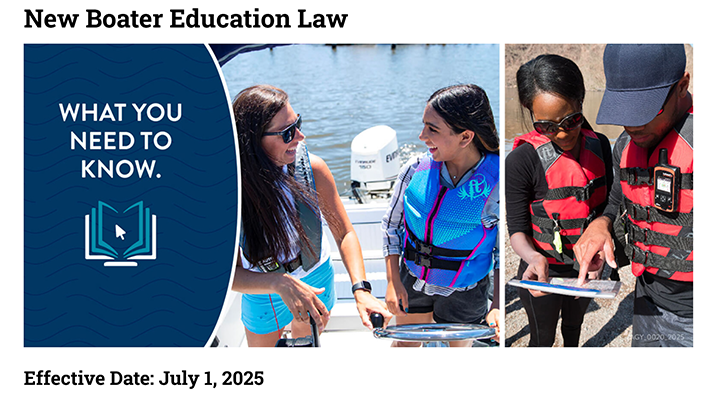 "An unexpected scheduling issue left me with a windfall of free time on Friday. So, I took advantage of it and got caught up with things on my “to-do” list. One of them, taking the course, and passing the test to obtain my Minnesota Boater Education Certificate. Oh, I know, it was not required of me, according to my age, it would never be required unless I planned to rent a bot someplace.
"An unexpected scheduling issue left me with a windfall of free time on Friday. So, I took advantage of it and got caught up with things on my “to-do” list. One of them, taking the course, and passing the test to obtain my Minnesota Boater Education Certificate. Oh, I know, it was not required of me, according to my age, it would never be required unless I planned to rent a bot someplace.
All that said, it will be required tomorrow, July 1, 2025 for everybody born after June 30, 2004, and are aged 12 or older. I figured the least I could do was to take the course, pass the test and learn what it is, exactly, that boaters are required to learn before taking control of a watercraft.
The course I signed up for was available from ilearntoboat.com and took maybe 4 to 5 hours to complete. The presentation, a “follow-along story” blends the subject matter with a sort of corny, but interesting, saga of a group of young adults who go on a series of boating adventures. There are frequent interruptions for spot quizzes aimed at testing one’s understanding of the course material. In order to move to the next level, a score of 80% is required. I stumbled on a couple of topics and was required to go back and re-study the material until I could complete the section quiz successfully. When the course is completed, the final exam, 60 questions, must be passed to obtain the boating certificate.
O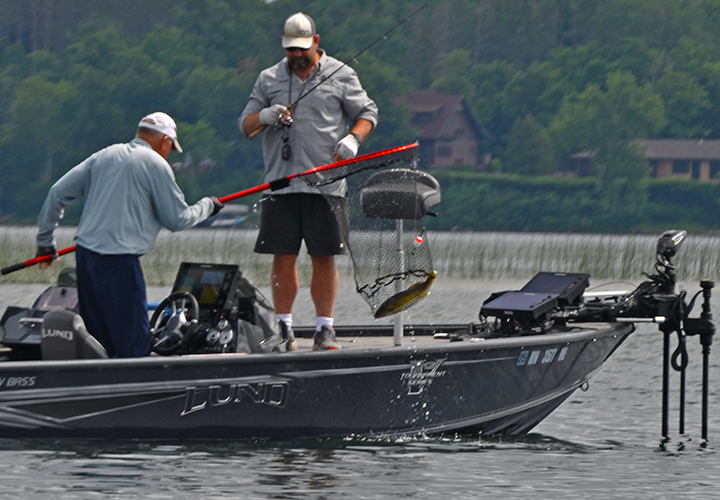 verall, the course was worthwhile and despite my 60 years of boating, still taught me a few things that I didn’t know. At the same time, it refreshed my memory about some things I did know but hadn’t thought about recently. Any criticism about the course content? Yes, it is not strict enough, especially in terms of covering boating and angling ethics. I think it could stress more the “good manners” required for all of us boaters to coexist on the water. Still, there was more good than bad, and reinforces my support for the boating certification requirements.
verall, the course was worthwhile and despite my 60 years of boating, still taught me a few things that I didn’t know. At the same time, it refreshed my memory about some things I did know but hadn’t thought about recently. Any criticism about the course content? Yes, it is not strict enough, especially in terms of covering boating and angling ethics. I think it could stress more the “good manners” required for all of us boaters to coexist on the water. Still, there was more good than bad, and reinforces my support for the boating certification requirements.
After a full day of studying and managing catch up work on Friday, I woke up on Saturday morning with an idea. “You know what sweetie,” I asked my wife? I’m thinking it might be fun to drive around on Pokegama Lake and take some pictures of folks in the GRAHA Walleye Tournament today.” It didn’t take long to get an agreement, the Hippie Chick, always ready for an adventure was ready to go in record time.
On the lake, we motored around, stopping occasionally, at respectful distances and snapped photos of some contestants. We got lucky at one stop and caught a glimpse of a live catch, a nice-looking walleye that was photographed and released. Most of the time though, all we watched were contestants staring into the screens of their advanced electronics.
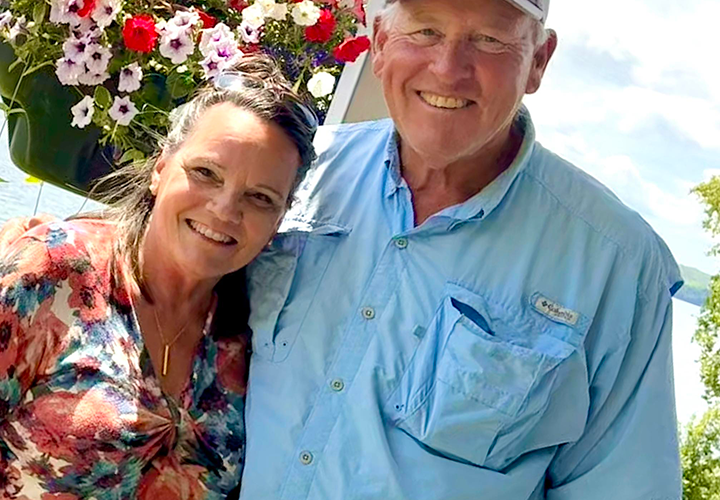 Susan said, at one point, “it doesn’t look like anybody is catching much of anything”. “Don’t worry sweetie, you’re going to be amazed when you see the final results at the end of the tournament. I’ll bet it’s going to take at least 40 pounds of walleyes to win it, and no matter how slow it looks right now, somebody is going to find them,” I offered.
Susan said, at one point, “it doesn’t look like anybody is catching much of anything”. “Don’t worry sweetie, you’re going to be amazed when you see the final results at the end of the tournament. I’ll bet it’s going to take at least 40 pounds of walleyes to win it, and no matter how slow it looks right now, somebody is going to find them,” I offered.
Well, congratulations to our friends Dylan Maki and Joe Bricco, 2 contestants who found over 41 pounds of Pokegama Lake Walleyes and took home $18,000.00 for their efforts. What about the rest of the field? Well, a quick look at the GRAHA Walleye Shootout Leaderboard reveals that there were more fish being caught than it looked like. Look, even to achieve 25th place took a whopping 30 pounds of walleyes, WOW, that's a lot of finding them! So, without naming all of our friends who were there, let me just say congratulations to everybody! It looks you all had a pretty darn good day out there and a couple of different fish, here or there, could have changed the outcomes for many.
As happy as I am for all of you who fished the tournament, I have to admit my day might have been more relaxing than yours. Especially gratifying for me was the the special "shore lunch" that I and the Hippie Chick enjoyed at the Pokegama Golf Course. Good food, great service, a nice view of the lake. Hmm .., it almost makes me think we should schedule this in every year.
On Sunday, I was back to work, and with a more gratifying assignment than usual. “We don’t need to bag a lot of fish, we just want to learn the ropes about different techniques and fishing situations,” my crew advised. “Let’s look for some walleyes, and maybe some crappies and we’d really like to learn how to find more bluegill too,” they said.
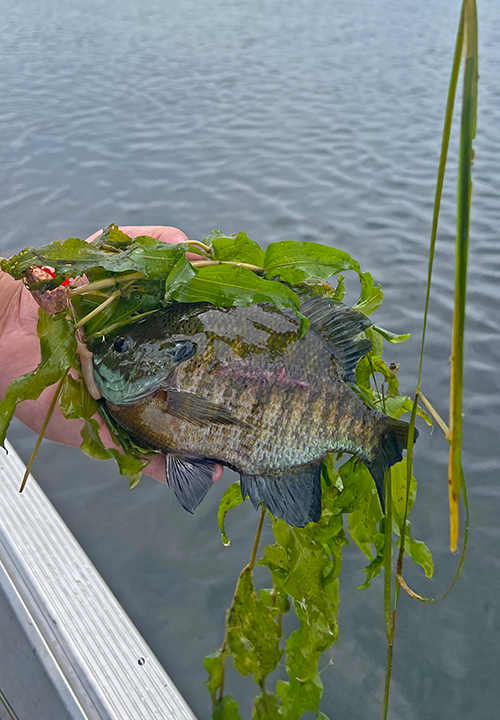 Without going overboard on details, I’ll condense the report to the basics. We found some walleyes and caught them on mid-lake bars in water depths of 18 to 22 feet. The structures featured sandy tops, with soft tapering drop-offs breaking into deeper, soft bottom areas. There was evidence of an insect hatch emerging, with what appeared to be suspended larvae on my graph. Later, we also found adult mayflies floating on the surface. That probably explains why the walleyes were out there, and why we never found any of them in the weeds, or along shoreline breaks.
Without going overboard on details, I’ll condense the report to the basics. We found some walleyes and caught them on mid-lake bars in water depths of 18 to 22 feet. The structures featured sandy tops, with soft tapering drop-offs breaking into deeper, soft bottom areas. There was evidence of an insect hatch emerging, with what appeared to be suspended larvae on my graph. Later, we also found adult mayflies floating on the surface. That probably explains why the walleyes were out there, and why we never found any of them in the weeds, or along shoreline breaks.
My search for crappies didn’t work out as well. I tried several types of cover, and we attempted to catch them using jigs, and also spinners. We caught almost every other kind of fish that swims, except for crappies. Dogfish, bullhead, rock bass, perch and lots of pike all struck the spinners aggressively. The level of activity reinforced my theory that walleyes were biting, but mostly located on mid-lake structures until the mayfly hatches run their course.
The search for bluegills was more successful. We trolled spinners, tipped with ½ night crawlers through the weeds until we encountered a couple of sunfish. Once located, we switched over to 1/16-ounce jigs, tipped them with cut pieces of night crawler and wet them below clip-on-bobbers at about 3 feet deep. Bluegills, as you can see here, were held in very heavy vegetation. The best territory was a combination of clasping leaf pondweed, combined with flat stemmed pondweed along a shallow, 4-to-7-foot deep breakline.
Like all of the other fish we encountered, the sunfish were active and struck readily. The area we fished featured warm, 75-to-76-degree water, and reminded me that my favorite time of the summer is fast-approaching. The warmer the water gets, the better the action will be, and we could be looking at an action-packed Independence Day holiday weekend ahead." ![]() — Jeff Sundin, The Early Bird Fishing Guide Office Cell Call or Text 218-245-9858 or Email on Facebook on X
— Jeff Sundin, The Early Bird Fishing Guide Office Cell Call or Text 218-245-9858 or Email on Facebook on X
 Brainerd MN Area Fishing Report June 30, 2025
Brainerd MN Area Fishing Report June 30, 2025
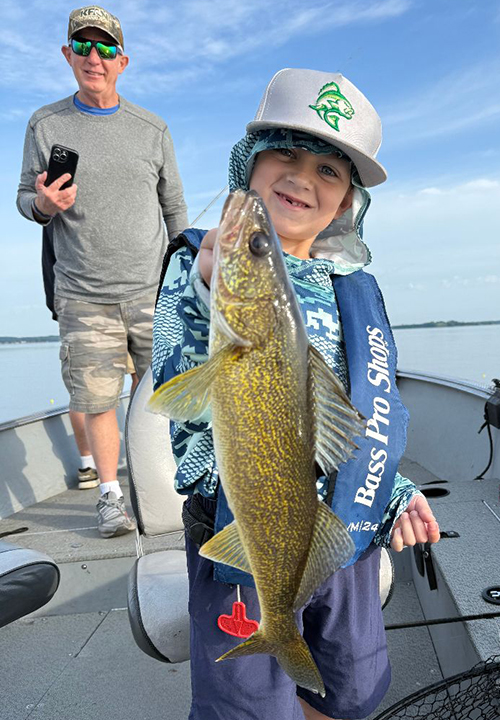 "After a period of crazy, unsettled weather, conditions stabilized, and fishing in the Brainerd Lakes area is picking back up. Largemouth bass are consistent and found holding close to areas that provide good weed cover. Jerkbaits, soft plastics, ned rigs, and bobbers are all working well.
"After a period of crazy, unsettled weather, conditions stabilized, and fishing in the Brainerd Lakes area is picking back up. Largemouth bass are consistent and found holding close to areas that provide good weed cover. Jerkbaits, soft plastics, ned rigs, and bobbers are all working well.
For musky, some are venturing into open water but there are still a large number of fish in the weeds. Bucktails, and rubber have been best.
As for walleye, summer patterns are developing well. Fish are holding along weed edges. I have been finding walleyes from 8 t o 22 feet of water. If you can find good cabbage it has been the best. Larger walleyes have been holding slightly deeper on rocks.
Presentations include a jig and night crawler worked slowly above the fish; this presentation has been getting the "active fish". When that doesn’t work, following up with a slip bobber and leech combination has been working well. The more finicky walleyes respond well to the slower, more methodical presentation.
Under the bobber, jigs have been working, but I have a preference for using a plain hook, especially when using leeches. Remember, by using agressive hook sets, you'll catch more walleyes. Instead of "hitting" the fish hard, try quickly reeling into the fish, and then gently sweep your rod to set the hook.
Keeping the bait 2 to 6 feet above the fish, depending on water clarity, will trigger fish to move upwards and strike your lures. Most walleyes have been in pods of 2 to 6 fish. Working through pods quickly has been key. If a bigger pod has been found sometimes waiting the out for a bit longer has been working if the fish will hold tight. Bait shops like S&W or sportlands has good jumbo leeches in the area. Good luck and tight lines!" — Joe Billiar, Crooked Hat Guide Service • 507-469-2714
More Recent Fishing Reports
Follow on X • Follow on Facebook • Brainerd 6-30 • Sundin 6-27 • Sundin 6-26 • Sundin 6-25 • Ely MN 6-25 • Sundin 6-23 • Lake Winnie 6-20 • Ely MN 6-18 • L.O.W 6-18 • Lake Winnie 6-7 • Mushy Crappies 5-30 • Night Walleyes 5-26 • Lake Winnie Season Outlook • Radomski On Walleye Limits • Don't Land A Citation 5-1 • 200 • MN DNR Rule Changes 02-13 • MN Hall of Fame 01-24 • Charts 1-23-25 • MAPS 1-22-23 • Upper Red Lake 12-8 • Barotrauma Study 1-25-24 • Fish Consumption • Forward Sonar • Panfish Workgroup
 June 27, 2025 "Chilling the Chill-Able"
June 27, 2025 "Chilling the Chill-Able"
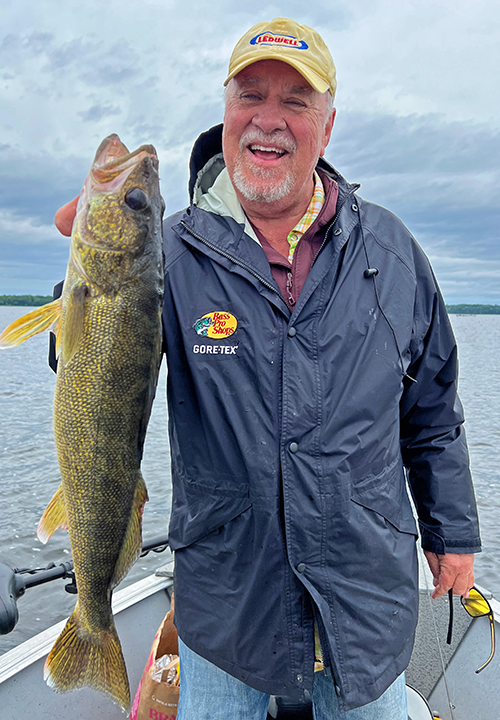 Without doubt, the recent rains have improved water levels in some of the shallowest lakes in my region. That said, the improvement is measured in inches, not feet, and I’m still getting wet when I load my Alaskan on the trailer at days end; that’s the bad news. The good news is that water levels have come up enough to float the back half of my boat, making the job of hand winching the boat somewhat easier.
Without doubt, the recent rains have improved water levels in some of the shallowest lakes in my region. That said, the improvement is measured in inches, not feet, and I’m still getting wet when I load my Alaskan on the trailer at days end; that’s the bad news. The good news is that water levels have come up enough to float the back half of my boat, making the job of hand winching the boat somewhat easier.
As the rains have fallen, air temperatures have dropped too and so are surface water temperatures. On Tuesday, I recorded 76 degrees as the high of the season, by Wednesday, I was looking at 72 to 74 degrees and yesterday, surface water had plunged to 70 degrees. The drop in water temperatures was sufficient to slow but not stop fish feeding activity.
After an easy day on Wednesday, yesterday marked the return of “working” to catch walleyes. Fish that struck aggressively, and were easy to hook on the day before, still struck on Thursday. This time though, the strikes were tentative, and not easily detectable. Finesse was required to allow sufficient time for the fish to engulf our night crawlers and leeches so that we could get good hooksets. Numerous strikes were missed because we didn’t wait long enough before attempting the hook set.
Because our goal was to catch only walleyes, I did not experiment much with trolling presentations. I do suspect though that cooler water temperatures might have taken the edge off of the mixed bag action bite. Typically, the warmer the water gets, the more active and more diversified the activity and mix of fish species gets. Sunfish and bass are the first to drop out, then the crappie action falls off and so on. So, if I got you excited about my report on June 25, 2025, I apologize, there may be a setback this weekend. To what extent, I won’t know until I’ve had a chance to try trolling with spinners again.
Yesterday, I mentioned my theory about low water levels encouraging some species of fish to evacuate the shorelines and show up along weed edges and shoreline breaks. Today, I’m doubling down on that theory because yesterday, we caught even more bullheads, small perch and tiny pike in areas where I usually don’t find them. In fact, Randy caught a bluegill while wiggle worming for walleye in an area where I’ve never seen one in 40 years. I suppose that sunfish, along with any others that live in that lake, usually spend their lives living in the shallowest weed patches, in areas where we can’t typically access them.
Wherever those panfish and small perch are “supposed to be”, I can hardly wait for water levels to rise so that they can go back there. When you can’t stop anyplace without catching perch in the 4-to-7-inch range, wiggle worming productivity goes down a lot. I can’t stop using the presentation because the walleyes are responding very well to it, but I have been going through a lot of night crawlers. Yesterday, we burned up 8 dozen of them and never caught a “keeper” perch the whole time.
Alternative presentations, like trolling crankbaits, or casting jigs with plastics are not getting the job done for me. Northern pike are striking them, so are the odd bass and crappie, but walleyes haven’t touched them this week. Maybe when the water warms back up next week, I’ll see a more diversified array of presentations. For now though, I’ll be planning my walleye trips around wiggle worming, and Lindy Rigs tipped with leeches or crawlers.
![]() Subscribe FREE Insider Newsletter • Contact Jeff Sundin, The Early Bird Fishing Guide • Office Cell Call or Text 218-245-9858 • Email • Facebook • X •
Subscribe FREE Insider Newsletter • Contact Jeff Sundin, The Early Bird Fishing Guide • Office Cell Call or Text 218-245-9858 • Email • Facebook • X • ![]()
 June 26, 2025 "Easing the Ease-Able: Walleye action Heats Up With Ideal Weather"
June 26, 2025 "Easing the Ease-Able: Walleye action Heats Up With Ideal Weather"
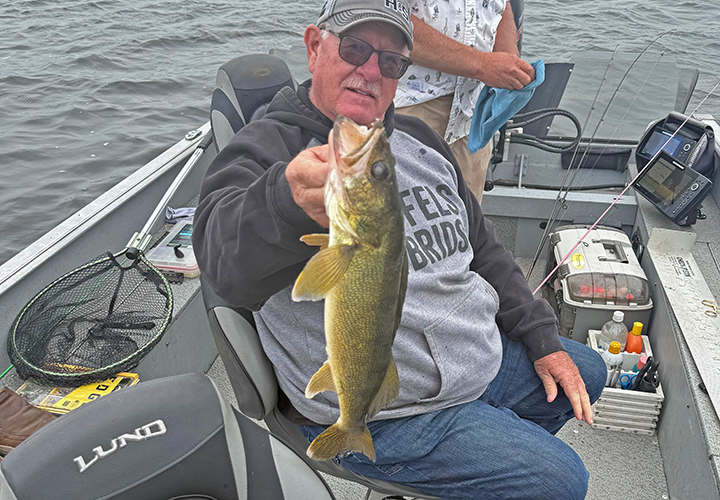 What, an easy day, seriously?
What, an easy day, seriously?
Yes, after a week or more of hunting and searching to catch walleyes one-by-one, the skies turned grey, the breezes blew in from the southeast and walleyes went on the prowl. Not only was it a welcome relief, but it also served to prove how much easier it is to catch fish when they are feeding, compared to when they’re resting.
Knowing that we’d be focusing 100% on walleyes, I selected a shallow, dark water lake that I’d fished on about a week ago. That day, we spent most of our time trolling spinners along the weed lines, catching mostly crappie’s, perch and northern pike. We did take some time to try for walleyes that day, and while the action was slow, we did get a few. So, yesterday I figured on spending the entire day moving from spot to spot, picking a walleye here and there, until we amassed enough whitetails to make the crew happy.
When we arrived at the lake, the surface water temperature was 72 degrees, where it held steady all day long. The skies were dark, threatening rain and there was a moderate southeast wind. Not enough to form whitecaps, but just the right amount of movement for a steady drifting speed of about .6 MPH.
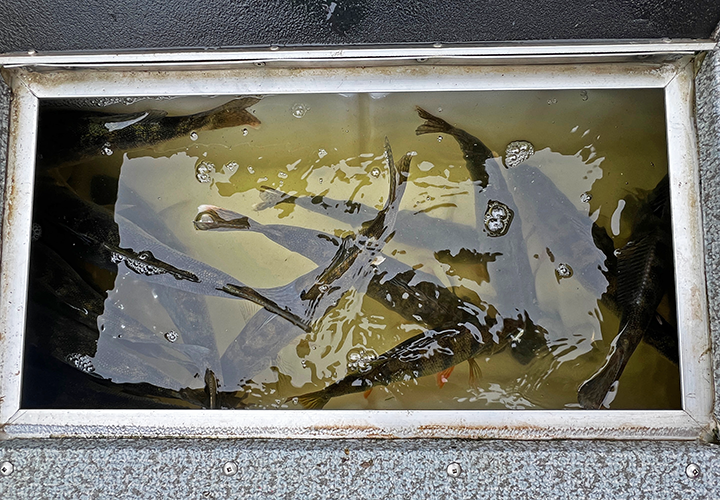 Previously, notherns had been very active on the lake, and I didn’t want to do anything to encourage them to strike our lures. So, skipped rigging the spinners, and left all of the minnows in the cooler. I rigged all 4 lines with 1/16-ounce Lindy Live Bait Jigs, and tipped 2 of them with might crawlers, the other 2 were tipped with large leeches. At the first stop, a clam bed, on a point that lays in about 8 feet of water and drops off into about 16 feet. We started our first drift in about 10 feet of water.
Previously, notherns had been very active on the lake, and I didn’t want to do anything to encourage them to strike our lures. So, skipped rigging the spinners, and left all of the minnows in the cooler. I rigged all 4 lines with 1/16-ounce Lindy Live Bait Jigs, and tipped 2 of them with might crawlers, the other 2 were tipped with large leeches. At the first stop, a clam bed, on a point that lays in about 8 feet of water and drops off into about 16 feet. We started our first drift in about 10 feet of water.
Remember, I arrived at the lake planning to spend the entire day spot-hopping and picking up walleyes at the same pace that we’ve experienced for the past 10 to 12 days. Imagine my surprise when at the end of the first drift, there were already 4 keepers in the livewell. Imagine too, the joy of having my crew’s entire limit of walleyes amassed in the livewell before lunch time.
I wish I could tell you that I knew the magic trick that made them bite, but I don’t. As is often the case these days, finding fish nowadays is fairly simple, it is getting them to bite that’s become more complex. When we happen to land on a lake where fish are already actively feeding, and then enjoy the added benefit of ideal weather, then the task of gathering them is easy.
Wiggle worming with whole night crawlers was an effective presentation yesterday. But so was swimming the light jigs with leeches, or night crawlers cut in half. For my crew, the ½ night crawlers was easier to use than wiggle worming and under the circumstances worked equally well. The magic depth, no matter where we stopped was about 9 feet of water. Anything shallower produced small perch and pike. Anything deeper, and the bullheads found out worms before the walleyes could.
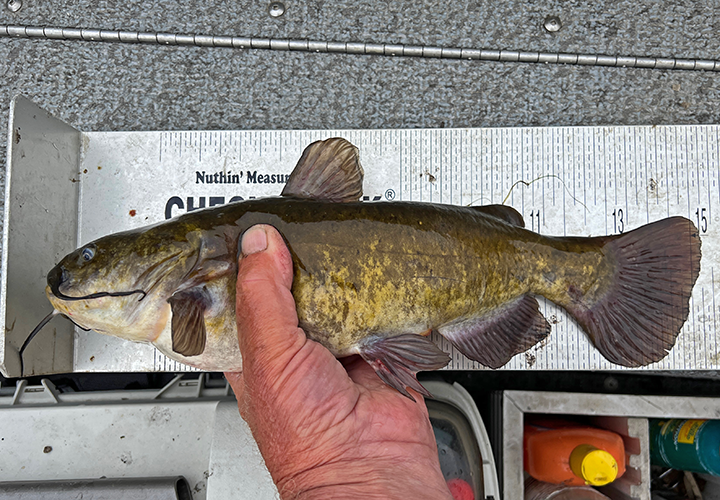 I was amused by some of the responses to my mention on social media about bullheads that we’ve been catching recently. Some folks jumped to the conclusion that they knew exactly where we were catching them, but nobody got it right. The truth is, we are catching them EVERYWHERE! Even lakes that have never produced a single bullhead in the past are now coughing up some big ones. Dogfish too, like I mentioned yesterday, are biting everywhere.
I was amused by some of the responses to my mention on social media about bullheads that we’ve been catching recently. Some folks jumped to the conclusion that they knew exactly where we were catching them, but nobody got it right. The truth is, we are catching them EVERYWHERE! Even lakes that have never produced a single bullhead in the past are now coughing up some big ones. Dogfish too, like I mentioned yesterday, are biting everywhere.
My theory is that the low water conditions have forced a lot of these fish out of shallow, weedy territory and onto the deeper weed edges where they are vulnerable. Small pike and under-sized perch too, seem to be inhabiting the weed lines in larger numbers and I think for the same reason.
Yesterday I wondered if anybody knew how to prepare a dog fish so as to make them useful for the table. While I have received some comments, so far, nobody has shared a recipe. Today I’ll throw out the same question about bullheads. I’ve enjoyed them in the past, and I know that a lot of other folks eat them regularly. What I don’t know, and hope you will share, is the best recipe for cooking them. When you think of it, a bonus meal of fish like the beauty you see pictured here could hit the spot, occasionally.
Today, I won’t expect the fishing to be as easy as yesterday, but you can bet that I’ll be hoping for it! Check in on Friday to find out. ![]() — Jeff Sundin, The Early Bird Fishing Guide Office Cell Call or Text 218-245-9858 or Email on Facebook on X
— Jeff Sundin, The Early Bird Fishing Guide Office Cell Call or Text 218-245-9858 or Email on Facebook on X
 June 25, 2025 "Mixing The Mix-Able, Mixed Bag Action Bite Heats Up"
June 25, 2025 "Mixing The Mix-Able, Mixed Bag Action Bite Heats Up"
 Monday and Tuesday have started the first week, for me, that customers have enjoyed a truly mixed bag fishing trip. What I mean is that it’s the first week when almost every species in a lake strikes on the same fishing presentation. Crappie, sunfish, northern pike, bass, walleye, bullheads, perch and dogfish have struck spinners when trolled on, or just outside the weedline.
Monday and Tuesday have started the first week, for me, that customers have enjoyed a truly mixed bag fishing trip. What I mean is that it’s the first week when almost every species in a lake strikes on the same fishing presentation. Crappie, sunfish, northern pike, bass, walleye, bullheads, perch and dogfish have struck spinners when trolled on, or just outside the weedline.
On Monday, the blustery winds presented problems in that some areas of the lake were un-fishable. But in shoreline areas where boat control was possible, most species, except for walleyes, were held in the weeds. On that trip, walleyes were out deeper, on mid-lake bars in water depths of 16 to 20 feet. On that trip, spinners and minnows worked well in the weeds, but the whitecaps forced us to abandon the spinner.
Using the drift bag, and backing into the waves with the outboard, we were able to slip along the break while we fished with heavy jigs, tipped with ½ night crawlers. Jig jig and crawler presentation worked, and we did boat a half dozen walleyes, but there may have been a better presentation if we’d been able to try it.
On Tuesday, the wind stopped, the sun came back out, and water temperatures rose, At the beginning of our day, 72 to 73 degrees were the most common readings. But late afternoon, I was reading temperatures of nearly 75 degrees. The sunshine encouraged development of an algae bloom too, and hour by hour, the water became cloudier.
Weeds, in about 7 to 9 feet of water were the epicenter of almost all of our action. The weed edges produced almost every species of fish except for walleyes. This time, walleyes were located a few feet deeper, but still along the shoreline breaks. They were using the weed free zone, in water depths of 10 to 12 feet of water. This time, they responded well to the spinners tipped with minnows and struck aggressively.
 We had a respectable catch of walleyes, but two things held us back from harvesting large numbers. First, walleye locations were widely varied, there were a few fish located on every shoreline, but not a lot of them located in any one place. So, time worked against us, and the catch rate was slower than it might have been, had fish been more concentrated.
We had a respectable catch of walleyes, but two things held us back from harvesting large numbers. First, walleye locations were widely varied, there were a few fish located on every shoreline, but not a lot of them located in any one place. So, time worked against us, and the catch rate was slower than it might have been, had fish been more concentrated.
The lake’s protected slot became the 2nd reason our harvest was limited. Walleyes in the 20-to-24-inch range are protected on this lake, and for the most part, that was the size range of fish we caught. Fish under 20 inches were rare, but we did bag 4 of them. Fish over 24 inches were rare too, but pictured here is Bryce Demuth holding a 24-1/2-inch walleye, the largest fish of the day. Advised that he could keep it if he wanted to, Bryce chose to release the fish instead, a good decision, I think.
We would have harvested northern pike too, but again, the protected slot prevented bagging large numbers. We caught numerous fish in the 23-to-25-inch size range, but only added 3 fish, 20 to 21 inches to the larder on this trip. Like walleyes, pike came at random intervals, and most were located outside of the weeds, along the clean breakline in about 10 feet of water.
Crappies and sunfish were holding tight to, and in the weeds. Flat stemmed pondweed was the best cover for crappies, but there were other varieties holding panfish too. Thick, green and matted, some weeds have become so thick that trolling spinners through them has become impossible. We were able to coax some of them out using bobbers to suspend 1/16-ounce jigs tipped with minnows. To really get in on the action here though, an early morning or late evening timeframe would have been ideal. Still, crappie action was good overall, and we were able to sort out 16 fish in the 10-to-11-inch size range. Numerous 9-to-10-inch fish were released in the hope that we can try for them again next year.
Dogfish, ordinarily caught only occasionally, are on a rampage right now. I think we’ve landed or almost landed upwards of a dozen in the past 2 days. Whether you love them or not, you’ll have to admit they put up a tussle. I can’t think of any fish in my region that fights harder than they do. I’m curious, do you, or any of your friends ever harvest dogfish for the table? If so, I’d love to hear more about how they are utilized.
Today, I have the same crew again, and we’re going to take a harder run at walleyes. I’m not sure yet where we’ll wind up, but how we fare will be the subject of tomorrow’s report. ![]() — Jeff Sundin, The Early Bird Fishing Guide Office Cell Call or Text 218-245-9858 or Email on Facebook on X
— Jeff Sundin, The Early Bird Fishing Guide Office Cell Call or Text 218-245-9858 or Email on Facebook on X
 Ely Area, Arrowhead Outdoors Fishing Report June 25, 2025
Ely Area, Arrowhead Outdoors Fishing Report June 25, 2025
 Walleye - How skinny is too skinny? That is what walleye anglers have been asking about "skinny water" this last week. Anglers have been reporting that they are catching quality walleyes in as little as 2 feet of water this last week, even during the middle of the day, on clear water lakes. Anglers finding them this shallow have been fishing paddle tails, floating raps and leeches under a bobber. Keep in mind this is happening on windy shorelines and often over rocks.
Walleye - How skinny is too skinny? That is what walleye anglers have been asking about "skinny water" this last week. Anglers have been reporting that they are catching quality walleyes in as little as 2 feet of water this last week, even during the middle of the day, on clear water lakes. Anglers finding them this shallow have been fishing paddle tails, floating raps and leeches under a bobber. Keep in mind this is happening on windy shorelines and often over rocks.
Not every lake is doing the same thing, so other anglers have been reporting a great bite happening at 6 to 10 feet of water. These anglers have been reporting the same baits are working here. Still other anglers have been reporting an excellent bite happening on weed lines and sunken islands in that 12 to 18 foot of water range. Anglers fishing here are catching walleyes with spinner rigs tipped with a crawler or leech. Gold, firetiger and pink were hot colors this last week.
Smallmouth - The great topwater continues on many of the Ely area lakes, but signs are starting to show it's slowing down. Early mornings have been the best time to fish topwater for smallies. As the sun gets up that bite cools off and subsurface baits like square bills, wacky worms, Ned rigs and paddle tails start producing equally as well. Key areas have remained the same, large boulders, rocky points, current areas and around downed trees. 10 feet and less remains the best depth.
Panfish - Sunfish have remained a popular target this last week as they are still spawning on many Ely area lakes. Small chunk of a night crawler or wax worm, both fished under a bobber, has been very effective. Anglers should be looking for sandy bottoms, in the shallows. Crappies are still being found just off weedbeds. White twisters, beetle spins and small jigs tipped with a crappie minnow and fished in 10 to 15 feet of water. During evening hours look for crappies to slide in a little shallower, in the weedbeds.
Stream Trout - Rainbow trout fishing continues to be excellent this last week. Many anglers reported catching good numbers of rainbows with small red/gold kastmasters, 2 inch white twisters, small brightly colored minnow baits and night crawlers fished about 5 to 10 feet under a bobber.
Lake Trout - Lake trout fishing continues to be good both inside and outside the BWCA. Warmer temps have pushed them down a little but anglers continue to find them in 25 to 80 feet of water. Anglers fishing from a boat have been using down riggers to get large trolling spoons down. Anglers fishing from a canoe have been drifting over deep water while fishing with heavy tubes, bucktails or heavy spoons.
Pike - Anglers targeting pike this last week picked up and good numbers of quality pike were caught, but trophy pike, over 40 inches, were few and far between, which is normal this time of the year. Anglers have been using large spoons, large spinnerbaits and large minnow baits in 6 to 14 feet of water. Weedlines, mouths of shallow bays and areas where water comes into the lake has been the areas to target.— Arrowhead Outdoors, 218-365-5358
 Lake of the Woods, LOW Tourism June 24, 2025
Lake of the Woods, LOW Tourism June 24, 2025
 "It’s been another excellent week of summer walleye fishing on the south side of Lake of the Woods. Many anglers are catching good numbers of walleyes and saugers using a variety of techniques. One notable walleye bite took place this week along Pine Island, with walleyes being caught in 12 to 15 feet of water.
"It’s been another excellent week of summer walleye fishing on the south side of Lake of the Woods. Many anglers are catching good numbers of walleyes and saugers using a variety of techniques. One notable walleye bite took place this week along Pine Island, with walleyes being caught in 12 to 15 feet of water.
Across the south shore, there are three main methods producing fish right now: jigging, pulling spinners, and trolling crankbaits.
Spinners tipped with night crawlers are working well when fished in water depths ranging from 12 to 35 feet, Here, anglers are targeting various schools of walleyes across the sand, mud flats and near structure.
The jig bite is still putting fish in the boat for many anglers, especially those anchoring up or using spot-lock over concentrated schools. A frozen emerald shiner or fathead minnow continues to be the go-to bait when jigging. However, as summer progresses and water temps rise, more anglers are shifting toward spinners and crankbaits to cover more water and locate active fish.
Trolling crankbaits is gaining momentum as a productive technique. Cranks not only cover water quickly, but they also offer a chance at bonus fish like pike and perch.
What colors? With the stained waters of Lake of the Woods, gold or gold combined with pink, orange, chartreuse or glow white are good options.
 On the Rainy River, the multi-species action bite is in full swing. There’s a reliable local population of walleyes and saugers, with fish being caught in deeper holes and along channel edges. Smallmouth bass are very active and can be found around current breaks, rocky shorelines, and along weed edges.
On the Rainy River, the multi-species action bite is in full swing. There’s a reliable local population of walleyes and saugers, with fish being caught in deeper holes and along channel edges. Smallmouth bass are very active and can be found around current breaks, rocky shorelines, and along weed edges.
Casting crankbaits, spinnerbaits, and soft plastics are all productive. Pike are spread throughout the river system, but back bays and areas with slack water near current breaks are reliable ambush points.
A reminder that sturgeon fishing reopens July 1st, and anglers with a sturgeon tag can harvest one fish per year within the slot (45–50 inches or over 75 inches) between July 1 and September 30.
Up at the Northwest Angle, fishing continues to be strong amongst the islands. Walleyes are being caught near structure in a variety of depths—12 to 24 feet has been especially productive. Jigging with minnows, pulling spinners with crawlers, and trolling crankbaits are all producing good results.
In addition to walleyes, anglers are catching a nice mix of perch, pike, crappies and smallmouth bass. As we move deeper into June, smallmouth action along rocky shorelines and shallow structure remains excellent. Muskie season opened this past weekend and initial reports were good. With 14,552 islands in LOW, there is a lot of habitat and a lot of fish!" — Lake of the Woods Tourism, (800) 382-FISH
 Wired2Fish June 24, 2025 "Chasing Bruiser Bluegills: Top Tips and Tactics for Catching Bulls"
Wired2Fish June 24, 2025 "Chasing Bruiser Bluegills: Top Tips and Tactics for Catching Bulls"
 "Growing up, I could always count on a certain fish to make my day. One that was always willing to bite and put a good bend into an ultralight. That species has made its way into the hearts and freezers of millions of Americans nationwide.
"Growing up, I could always count on a certain fish to make my day. One that was always willing to bite and put a good bend into an ultralight. That species has made its way into the hearts and freezers of millions of Americans nationwide.
You likely know it as the bluegill. For fishermen across the country, bluegills are often considered a stepping stone into getting hooked on fishing. They’re in most freshwaters across the country, and growing in abundance around the globe. Plus, panfish are relatively easy to catch.
While bluegills are widespread, finding big bluegills can be a challenge, especially catching them consistently. Standard tactics will work, but there are certain baits and presentations that ..." Read Article to Learn More >> Chasing Bruiser Bluegills: Top Tips and Tactics for Catching Bulls
 June 23, 2025 "Can You Talk Yourself Into Winning?"
June 23, 2025 "Can You Talk Yourself Into Winning?"
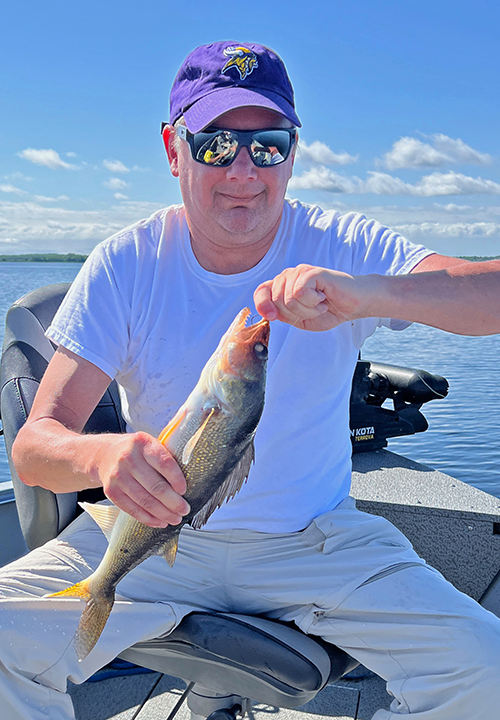 Can You Talk Yourself into Winning? The answer is YES you can, if you want to. But if you're not careful, you can think yourself right out of winning and into .... no, let's not even mention the "L" word.
Can You Talk Yourself into Winning? The answer is YES you can, if you want to. But if you're not careful, you can think yourself right out of winning and into .... no, let's not even mention the "L" word.
The past week hasn’t been an easy one, stormy weather, heat, calm seas, sunny conditions; all the things that keep guys like me awake at night.
In this line of work, tough conditions are part of the game and meager catches, occasionally, are a foregone conclusion. Even on tough days though, I understand that failing is not an option, and my task is to figure out a way to help my customers catch something. So, on days when odds are stacked against catching fish, it’s on me to be the “cheerleading section” that keeps the crew’s heads in the game and moving toward that goal. Sometimes the job is easy, other times, it can be more complicated.
Long-time readers of these reports recall stories about the powers of positive thinking. Terms I’ve used like “The Snyder Effect”, “Rainbow Fish Meditation” and ‘Willing Fish to Bite” come up in articles periodically. The concept culminated in a presentation I provided as a guest speaker for the Fargo Moorhead Walleyes Unlimited club. The title, “Better Angling Through Inward Facing Technology” focuses on the powers within all of us, to win at fishing, even on days when the books say we are “expected to lose”.
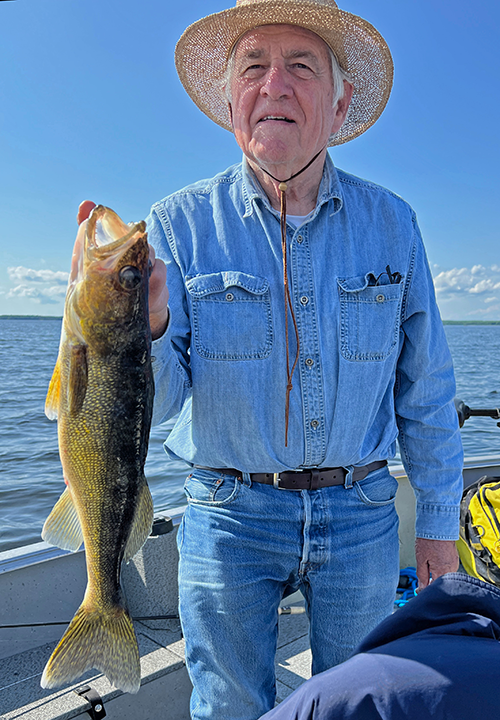 For me, the past week has provided numerous real-time examples of how the philosophy “Inward Facing Technology” really works, and how it sometimes doesn’t. Without over-glorifying catching a few fish this week, let me say; even when catching “seems” impossible, it can be done, if you want to.
For me, the past week has provided numerous real-time examples of how the philosophy “Inward Facing Technology” really works, and how it sometimes doesn’t. Without over-glorifying catching a few fish this week, let me say; even when catching “seems” impossible, it can be done, if you want to.
We already know that when the sun shines, and the water is calm, clear water lakes can be harder to fish. So, to combat bright conditions, I’ve been fishing on lakes like Bowstring, Round, Splithand and others. Conditions on all of them have been similar, stained water, large expanses of shallow water flats and heavy in some areas, heavy weed growth. Surface water temperatures on all of them have risen, ranging between 71 and 73 degrees and that has encouraged some algae development.
The good news is that fish, on every lake have been “semi-active” and willing to strike. The bad news is that populations are widely scattered. Locating larger schools of fish has not been my experience. Finding small packs of 3 to 12 fish has been the routine and catching maybe 1 or 2 at a time has been the norm. So, the first obstacle to amassing decent creels of fish has been the need to move a lot.
Feeding preferences have been all over the map too. We’ve caught walleyes using jig and minnow, Lindy Rigs with night crawlers or leeches, heavy weight jigs with leeches, light weight jigs with leeches, heavy weight jigs with ½ night crawlers, light weight jigs with whole night crawlers, spinners with minnows, and slip bobbers with leeches. Often, we’ve caught one fish using a given presentation, then switched over to using that presentation, only to get snubbed by the remaining fish. When we experiment, we find another fish that will strike a different presentation, switch over to it, and the process repeats.
This is where the mental part, the “Inward Facing Technology” part comes into play. For folks who stay interested and are prepared to make frequent moves while trying a variety of presentations, catching walleyes has been possible. For people who get frustrated and lose interest in search-and-seizure style fishing, the task becomes much more difficult. So, unless catching walleyes are the only acceptable outcome, this style of fishing may not be for everybody right now.
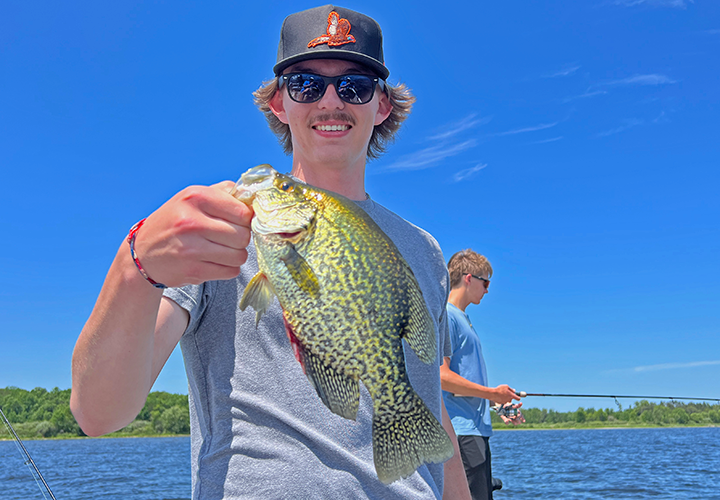 When I’ve been fishing with people who do not enjoy searching for walleye, and would rather just catch some fish, the work has been a lot easier. Crappies, bass, perch and LOTS of northern pike are on the weed edges, and they have been much more active. Even bullheads have been aggressive enough to strike trolling presentations along the weedline, and soft bottom, mid-lake breaklines.
When I’ve been fishing with people who do not enjoy searching for walleye, and would rather just catch some fish, the work has been a lot easier. Crappies, bass, perch and LOTS of northern pike are on the weed edges, and they have been much more active. Even bullheads have been aggressive enough to strike trolling presentations along the weedline, and soft bottom, mid-lake breaklines.
The standard summer trolling presentation, spinners tipped with fathead minnows has worked well. Along the shallow weeds, 3/16-ounce bullet weights provide plenty of weight. As you go deeper, increase the weight to keep your spinners running through the strike zone, usually about 2 to 3 feet above the bottom. On Thursday, we used ¾ ounce egg sinkers to hold spinners at depths up to about 18 feet, and they worked well. I think I will keep using these weights, rather than the bottom bouncer style weights I’ve used in the past. The bottom bouncers work fine, but the extra weight, along with the added hardware makes them more cumbersome to use.
Despite having better action overall with the spinners, catching walleyes on them has been rare. I can’t explain why, but right now, walleyes seem to prefer deeper, open water structure over the shoreline weed beds. This may change on the lakes I’ve been fishing for them, and as far as I know, walleyes on other lakes, especially ones with deeper weed growth, may be located there already.
Today, I’ll start a 3-day stint with a family who typically enjoys fishing with the spinner presentations. They love catching walleyes, but they love having action even more, so I expect to take my search for fish in different directions. I’ll know more about fish locations on some of the deeper water, mult-species lakes by the middle of the week.
Finally, if I piqued your interest about the topic I mentioned earlier, you can learn a little more about it here >> “Better Angling Through Inward Facing Technology”. If you’re a member of a fishing club, and occasionally host guest speakers, let me know because the topic was well received at the FM Walleye Unlimited gathering last winter. I’d love to connect with you, and provide a seminar for your club or fishing organization. ![]() — Jeff Sundin, The Early Bird Fishing Guide Office Cell Call or Text 218-245-9858 or Email on Facebook on X
— Jeff Sundin, The Early Bird Fishing Guide Office Cell Call or Text 218-245-9858 or Email on Facebook on X
 Cutfoot Sioux, Lake Winnie Memorial Day Fishing Report June 21, 2025
Cutfoot Sioux, Lake Winnie Memorial Day Fishing Report June 21, 2025
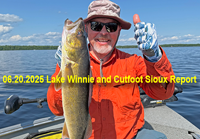 "Ask around at the evening campfires and folks are likely to have varying opinions about walleye fishing on Cutfoot and Winnie this week. Some anglers who know the lakes and have fished here a lot will say that they’ve done well. Some, in fact, have been doing very well! But ask less experienced anglers and they will probably say that they’ve struggled to catch walleyes consistently.
"Ask around at the evening campfires and folks are likely to have varying opinions about walleye fishing on Cutfoot and Winnie this week. Some anglers who know the lakes and have fished here a lot will say that they’ve done well. Some, in fact, have been doing very well! But ask less experienced anglers and they will probably say that they’ve struggled to catch walleyes consistently.
There’s no doubt, walleye fishing has had its ups and downs this year. One day that features fabulous catches can be followed by another that dishes out modest catches. Clear water, bright conditions, changeable weather, and migrating fish have all made contributions to causing trouble.
Walleye location now centers on the lake’s larger bars like Horseshoe, Moses, Sugar and Center. On those “main bars” there are miles of flats, areas where water depths ..." Read >> Bowen Lodge Lake Winnie Fishing Report June 20, 2025 June 19, 2025 "Detailing the Detail-Able"
June 19, 2025 "Detailing the Detail-Able"
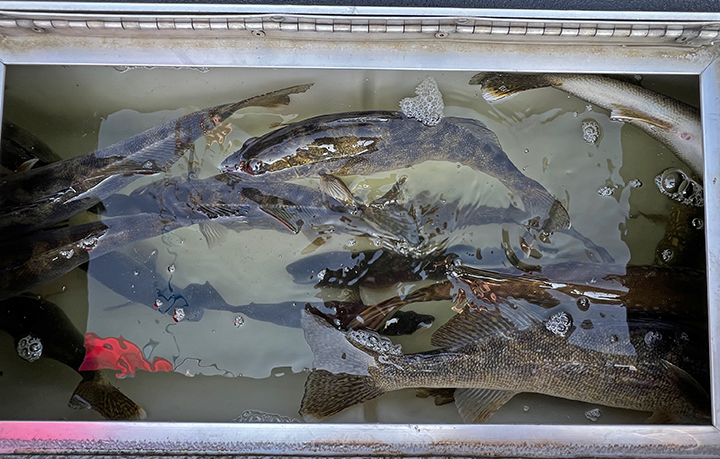 Everybody knows somebody who pays attention to every little detail. You know, like the lady who can give you directions to the nearest hardware store using every landmark along her preferred route. That’s not me, I’m the guy who says, “just keep driving north and west, you’ll wind up there eventually”. Both ways work, and both ways have their benefits, and their drawbacks.
Everybody knows somebody who pays attention to every little detail. You know, like the lady who can give you directions to the nearest hardware store using every landmark along her preferred route. That’s not me, I’m the guy who says, “just keep driving north and west, you’ll wind up there eventually”. Both ways work, and both ways have their benefits, and their drawbacks.
For me, the instinctive approach to fishing “usually” gets me where I’m going, but it can sometimes take longer to get to my destination. Take yesterday’s trip to Bowstring Lake for example; by day’s end, our livewell was full, but the journey to filling it was a long one.
First things first, the water level, according to friends I met at the landing, had risen a couple of inches after the rain on Monday evening. So, if you had trouble launching your boat there last week, it hasn’t improved enough to make your task easier this week. That said, it hasn’t gotten any worse, so if it was good to go last week, it will be fine this weekend too.
On the lake, water temperatures we cool in the morning, but rose quickly throughout the day. At 9:00 AM, 66 to 67 degrees was the range, and by 6:00 PM, I saw surface readings of 72 to 73 degrees. As the water warmed, a light algae bloom began developing, but overall, the water was clear, for Bowstring. We didn’t take a Secchi Disk reading, but whenever we fished shallower than about 8 feet deep, we could easily see the bottom of the lake.
Walleye location appears, for now, to be centered around the Mid Lake bars. Shoreline weeds, and steep breaklines we fished were inhabited primarily by small pike. We caught a couple of shallow water walleyes, and a couple of crappies trolling with spinners along the shoreline. But it wasn’t good enough to hold my attention.
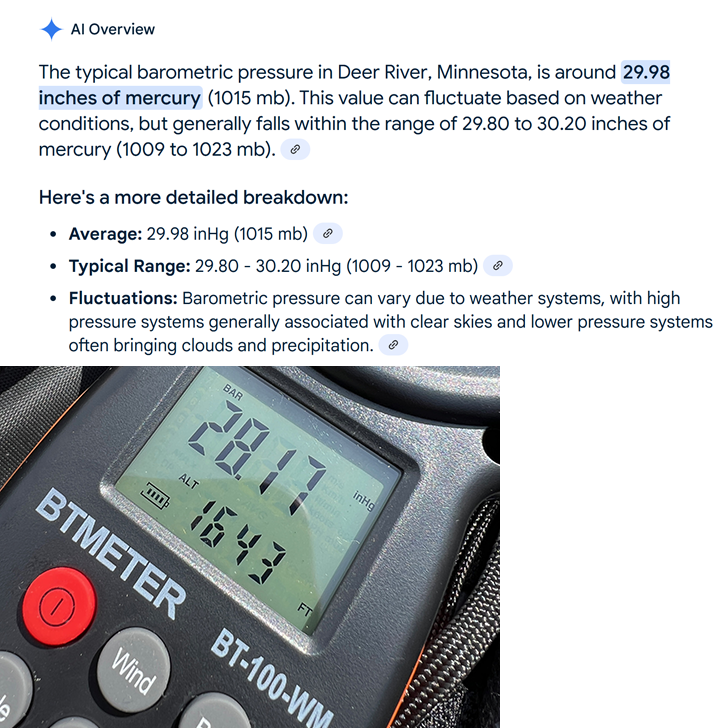 For me and my crew, fishing in water depths of 17 to 21 feet was the most reliable. But we did also catch some smaller walleyes in shallower, 14-to-16-foot water depths too. There were numerous small fish, 10 to 13 inches in length caught and while not helpful for yesterday’s goal, represented good news for future seasons.
For me and my crew, fishing in water depths of 17 to 21 feet was the most reliable. But we did also catch some smaller walleyes in shallower, 14-to-16-foot water depths too. There were numerous small fish, 10 to 13 inches in length caught and while not helpful for yesterday’s goal, represented good news for future seasons.
Presentations varied, we caught a few using jigs tipped with shiners, a few using leeches on jigs and some more using Lindy Rigs and night crawlers. Toward the end of the day, I experimented with ¼ ounce jigs tipped with a half night crawler. That presentation worked, and was simpler than using the Lindy Rigs, and I’d be sure to try it again if I was heading there again soon.
Like I said, the journey to a full livewell was an all-day long process. Friends who were fishing the lake compared notes with me and agreed, catching fish was a slow-but-steady process. Last week I speculated about low barometric pressure, and slow fishing action. In attempt to be more of a “detail angler” and less of an “instinctive one” I picked up a new tool. The BTMETER used to measure barometric pressure in real time should help me compare fish activity with the barometer.
I hope I can trust the A.I. information I looked up yesterday, and if I can, there is early evidence that supports the theory. At a barometric 28.17 inches, low compared to the 30-inch, approximate average for Deer River, Minnesota, walleyes were sluggish and slow to strike. I’m anxious to see, and share with you some of the anecdotes about future correlations between the barometer, and fish activity.
Right now, I’m up against the clock and need to wrap it up. But I’ll report more about this, and whatever we do today, in the coming days. ![]() — Jeff Sundin, The Early Bird Fishing Guide Office Cell Call or Text 218-245-9858 or Email on Facebook on X
— Jeff Sundin, The Early Bird Fishing Guide Office Cell Call or Text 218-245-9858 or Email on Facebook on X
 June 18, 2025 "What, Pike Won't Bite, Seriously?"
June 18, 2025 "What, Pike Won't Bite, Seriously?"
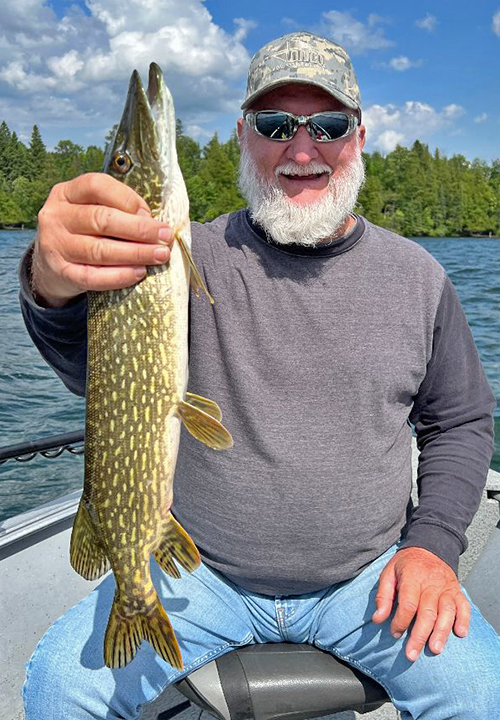 You’ve heard the expression “no good deed goes un-punished”, right? Well, it seems like I’m in the process of earning my master’s degree on that subject from the University of Sunny Side Up.
You’ve heard the expression “no good deed goes un-punished”, right? Well, it seems like I’m in the process of earning my master’s degree on that subject from the University of Sunny Side Up.
For weeks now, it’s been hard to keep small, eating size northern pike off the hook. Some of my customers have called them every derogatory name in the book and at times, they’ve become an un-wanted nuisance. But let me decide, just once, to purposely select a lake with an attractive special regulation on pike, one where we can catch lots of them on purpose, and guess what happens? That’s right, the action dries right up! Go figure, small, eating size pike, often the bane of walleye anglers, becomes harder to catch than a runaway train.
The setback caused by a series of thunderstorms that rolled through the Bemidji region on Monday gave most of the pike where we were fishing on Tuesday a temporary case of lockjaw. Luckily, there was a welcome improvement during late afternoon, and we were able to catch some. But we drove a long way to get very few when we could have fished 5 miles from the hotel and caught just as many.
The reason I drove so far was to take advantage of the lake’s special, 24-to-36-inch protected slot size on northern pike. Look at the image of the plump, 23-1/2 fish held here by Bobby Cox and you’ll see why. When it comes to harvesting pike for the table, the difference between 21 (legal on most north central region lakes) and 23 (legal on some special regulation lakes) inches is HUGE. And when it comes to catching and releasing larger pike, the protected fish, 24 to 36 inches, are not just a blast to catch, but provide great photo ops too.
Typically flexible, presentations for pike yesterday needed to be more specific. The fish were buried deep in scattered patches of cabbage weeds. Trolling presentations were ignored, and so were aggressive jigging methods like swim baits or paddle tails. To get strikes, we had to use live minnows on jig heads to drop our offerings into pockets in the weed beds. Snagging the green plants was a common problem but this presentation was required in order to get the fish to strike.
The water depth was about 8 to 10 feet, so we used 1/8-ounce jig heads tied directly to 8-pound test monofilament. Often, we’d get a lot of bite-offs without using fluorocarbon leaders but yesterday we never got snipped off once. That’s more evidence that the pike were in a negative mood.
Luckily, I will fish with the same crew today, so I have a chance to give them another shot at better action. I have to decide though, whether we’ll be happier going for pike, or if we should take a run at catching walleyes instead. Whatever we decide, I’ll let you know tomorrow.
Before I go, let me ask for your help. I’ve mentioned recently that water levels have been extremely low on several lakes. As I drove through Deer River yesterday evening, I noticed that Monday’s rains brought water levels up a lot in the Deer River. Have you noticed water levels rising at all on any of your favorite lakes, or did the storms fall short of providing relief from the drought? Help out your fellow anglers by letting them know what you’re seeing out there. ![]() — Jeff Sundin, The Early Bird Fishing Guide Office Cell Call or Text 218-245-9858 or Email on Facebook on X
— Jeff Sundin, The Early Bird Fishing Guide Office Cell Call or Text 218-245-9858 or Email on Facebook on X
 Ely Area, Arrowhead Outdoors Fishing Report June 18, 2025
Ely Area, Arrowhead Outdoors Fishing Report June 18, 2025
 Walleye fishing reports are indicating that walleyes are shifting out more and more to the sunken islands and mud flats. Anglers targeting walleyes out here are using spinner rigs tipped with a crawler or leech. Humps that top out in that 12 to 18 foot of water range have been the most productive humps to fish. If a mud flat is located nearby, even better.
Walleye fishing reports are indicating that walleyes are shifting out more and more to the sunken islands and mud flats. Anglers targeting walleyes out here are using spinner rigs tipped with a crawler or leech. Humps that top out in that 12 to 18 foot of water range have been the most productive humps to fish. If a mud flat is located nearby, even better.
Reports continue to also come in of a good shallow water bite for walleyes. Here anglers have been doing good with minnows and leeches. Minnows during the day, pitched on a 1/8 ounce, firetiger, gold, pink or white jig heads, over shallow rocks in 6 to 8 feet of water. During the evening hours a slip bobber and leech has remained deadly in these same locations. Wind blown rocks have been the key.
Smallmouth Bass have wrapped up their spawning on the majority of lakes now and have recovered from the spawn. Topwater bite is in full swing right now. Whopper ploppers, poppers, torpedoes and spooks have been catching huge numbers of smallies right now. If topwater gets to be too exciting for you, wacky worms, chatterbaits, spinners and plugs are also catching lots of smallies right now. Best depth remains 10 feet of water and less.
Panfish • Sunfish have begun to spawn in many of the Ely area lakes. Shallow sand flats in the pencil reeds have been the areas to look for spawning gills. Wax worms, angleworms or small leeches fished in a bobber has been deadly.
Crappies continue to be found out in emerging weedbeds during the evening hours now. Jig and twister or crappie minnows under a bobber have been very effective. Some anglers have reported catching crappies in downed trees during the day. Not all down trees are created equally, so you may have to check a few downed trees before you find the right one. Bobber and crappie minnows, fished close to the trees have been very effective.
Stream Trout • Rainbows continue to be a popular catch this last week. Some really big rainbows have been caught this last week too. White twisters have been deadly for those fishing right off shore on local stream trout lakes. Anglers fishing from a boat have been trolling brightly colored minnow baits and/or small trolling spoons. These anglers have been simply trolling along shorelines about 5 to 10 feet down.
Lake trout continue to be found on the shallow side. 20 to 35 feet of water continues to be the best depth to find lakers. Trolling crankbaits and trolling spoons have been effective. For anglers fishing from a canoe, they have been drifting over deep water while jigging heavy bucktails or tube jigs.
Northern Pike reports continue to cool off, but not from a lack of catching fish. Anglers have been throwing large spoons along weedlines, river mouths and mouths of shallow bays and are reporting that they are catching good numbers of pike. Reports of anglers catching large pike while fishing a large sucker under a bobber, right off their docks. — Arrowhead Outdoors, 218-365-5358
 Lake of the Woods, LOW Tourism June 18, 2025
Lake of the Woods, LOW Tourism June 18, 2025
 "It's been another great week of fishing on the south side of Lake of the Woods! The bite remained strong throughout the area.
"It's been another great week of fishing on the south side of Lake of the Woods! The bite remained strong throughout the area.
Walleyes are active and transitioning in how they’re feeding and where they’re holding. The jig bite is still producing in many areas, with anglers anchoring or using spot-lock in areas with roaming schools of walleyes. A 3/8 to 1/2 ounce jig tipped with a frozen emerald shiner continues to be a top performer.
Classic Lake of the Woods colors include gold, orange, chartreuse, pink, and glow white, or a combination of these colors are producing well. Some anglers are beginning to use leeches on jigs with success, especially as water temps rise.
In addition to jigging, pulling spinners is becoming more effective. Many anglers are using crawlers on their spinner rigs, while others are experimenting with minnows for added variety. Hammered gold blades combined with pink, glow red, orange, or white remain great color options. This time of year, versatility can make all the difference.
Trolling crankbaits over deep mud is also gaining momentum as water temperatures climb. Cranks allow anglers to cover water efficiently and locate scattered fish. In addition to walleyes, this technique often produces bonus species like pike, smallmouth bass, and jumbo perch.
Productive depths have varied, but deeper mud and rocks in 25 to 35 feet have yielded strong results.
For anglers who enjoy using forward facing sonar, the deep mud shines for scoping fish. Tournament tip, keep an eye out for those monster walleyes just below the surface!
The Rainy River is still producing some nice walleyes. As water temperatures rise and the current remains steady, a 1/2 ounce jig tipped with a frozen emerald shiner is still effective, particularly when vertically jigged in deeper holes and along channel edges.
Looking to explore? Pulling spinners with crawlers or trolling crankbaits is a great way to cover ground and locate active fish. Troll along shorelines, weed edges and through various holes in the river.
Casting crankbaits, spinnerbaits, and swim jigs along shorelines, docks, and in back bays is also putting walleyes, pike, and smallmouth bass in the boat. A fun way to explore and catch a mixed bag.
With the strong sturgeon population, some groups are making plans to spend a few days relaxing while soaking some crawlers for the largest fish in Lake of the Woods, lake sturgeon. Sturgeon fishing reopens July 1st. From July 1 through September 30, anglers with a valid sturgeon tag can harvest one fish per year between 45 to 50 inches or over 75 inches.
Up at the Northwest Angle, fishing remains excellent at the Northwest Angle. Walleyes are being caught in 12 to 24 feet of water near shoreline structure, underwater points, and shallow reefs. The jig and minnow bite continues to be hot in traditional walleye areas such as points, neckdown areas and sunken islands.
Trolling crankbaits along shoreline structure such as points, rubble areas or weed edges will produce a mixed bag of walleyes, jumbo perch, pike, and smallmouth bass. If you aren't finding a big school of fish, covering water will normally produce. When you start catching, go back and forth in that area.
The muskie opener for both Minnesota and Ontario’s Zone 5 is Saturday, Lake of the Woods is known as one of the best muskie fisheries on the planet!
Plan Your Trip, Lake of the Woods continues to shine as a premier walleye destination. Whether you're jigging, pulling spinners, trolling crankbaits, or casting for a mixed bag, the lake is healthy and full of opportunity." — Lake of the Woods Tourism, (800) 382-FISH
 June 17, 2025 "Round Lake Report: Drought Conditions Persist"
June 17, 2025 "Round Lake Report: Drought Conditions Persist"
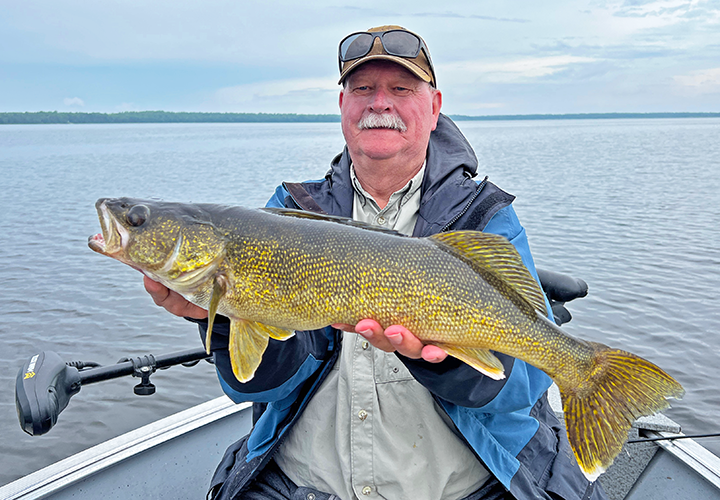 Some of the folks who live in and near Squaw Lake, MN may recall a time when conditions were dryer. For me though, the water at Round Lake was as low as I’ve seen in my 40 years of fishing there. Getting my Alaskan on the lake wasn’t terrible, but getting back off the lake at days end was a wet, hand blistering chore. That’s the bad news.
Some of the folks who live in and near Squaw Lake, MN may recall a time when conditions were dryer. For me though, the water at Round Lake was as low as I’ve seen in my 40 years of fishing there. Getting my Alaskan on the lake wasn’t terrible, but getting back off the lake at days end was a wet, hand blistering chore. That’s the bad news.
The good news is that a line of heavy rainstorms blew in late in the afternoon, and continued for about 3 hours, there was already a steady flow of water running down the access road, and into the lake by the time we left at 4:30 pm. So, temporarily at least, the water level should stabilize, and likely rise a little bit in the coming days.
On the lake, surface water temperatures ranged between 66 and 67 degrees. There was a light algae bloom going on, but water clarity was above average, for this lake. Showing on the screen of my graph, and spread evenly across the entire lake, was a mass of either baitfish, or developing insect larvae. The mass was about 5 feet below the surface, thinner in some areas, thicker in others, but present everywhere. There was no sign of any bug hatches on the surface, but there may be one coming soon.
Because of the low water level, I think, there were hundreds of skinny, 12-to-16-inch northern pike on the weed edges. Displaced from their shallow water sanctuaries where they’d ordinarily live, the small, hungry pike were aggressive. In my opinion, they were so active that catching any other species of fish on the weed edges became nearly impossible. We attempted to catch walleyes by moving slowly, and fishing with 1/16 ounce jigs tipped with either fathead minnows, leeches or night crawlers, but perch were the only fish attracted by those offerings.
Moving away from the weed edges and fishing deeper mid-lake structures using live bait might work better, I thought. That strategy did keep us away from some pike, and it did allow us to catch another species of fish; big, fat, Round Lake bullheads. I think we could have filled the livewell with them if we’d continued to fish there, but still searching for walleyes, we re-rigged, and moved out of that area.
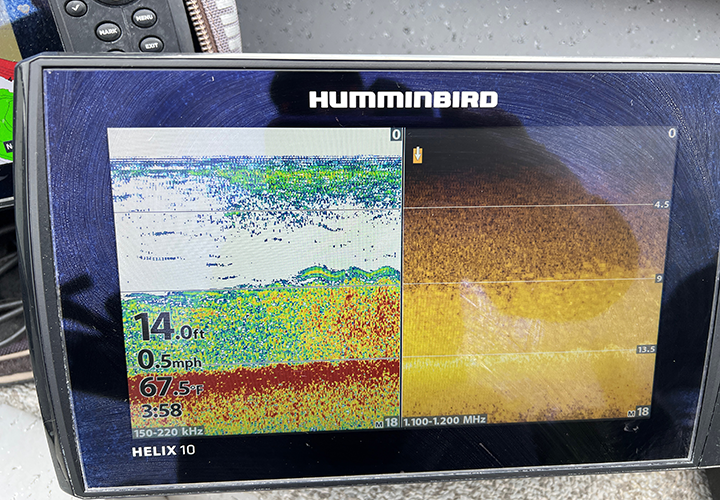 Pulling out the Ugly Sticks and spinner rigs, we began trolling in water depths of 7 to 10 feet. Tipping the spinners with either fatheads or night crawlers we finally began picking away at walleyes. They were not stacked up in any one spot, they were scattered. Even if we had to catch one fish at every spot, the strategy was working well enough to keep at it, and I would have if the rains had held off for a couple of more hours, but they didn’t. As the rain drops got heavier, and the frequency intensified, we moved toward the landing where one more stop along the weedline proved the little pike theory by catching another half dozen weed darts.
Pulling out the Ugly Sticks and spinner rigs, we began trolling in water depths of 7 to 10 feet. Tipping the spinners with either fatheads or night crawlers we finally began picking away at walleyes. They were not stacked up in any one spot, they were scattered. Even if we had to catch one fish at every spot, the strategy was working well enough to keep at it, and I would have if the rains had held off for a couple of more hours, but they didn’t. As the rain drops got heavier, and the frequency intensified, we moved toward the landing where one more stop along the weedline proved the little pike theory by catching another half dozen weed darts.
A look at the radar screen on my phone made the decision to quit an easy one. More, and stronger rainstorms were on the way, so we cut the trip short and headed for the landing at around 3:30 pm. You recall that earlier I said we left the lake by 4:30, right? So, that means it took me an hour to get the boat cranked up onto the trailer and get off the ramp.
Luckily, we had just enough time to figure out and catch a few walleyes. With more time to work on them, I think we’d have caught more, but for me, it’s gonna take a while to get back in the mood to launch the boat on Round Lake again. When conditions improve, I will.
I want to wrap up this morning with an observation, and a question. I recall a time when there was one shallow weedline in water depths of 4 to 6 feet, and some scattered stands of cabbage weeds growing in water depths of 6 to 8 feet. Today, there are weeds growing in deeper water, 12 to 14 feet deep in certain areas, and there are varities growing there that I have not observed in the lake before.
If, theoretically, Round Lake has yet to become infested with any “invasive species”, then why are there so many new forms of vegetation growing in relatively deep water? Is this simply evolution and eutrophication, or is there another explanation?
I’ll pass my questions along to some of the DNR folks I know, but I’d love to hear from readers who have knowledge to share as well. ![]() — Jeff Sundin, The Early Bird Fishing Guide Office Cell Call or Text 218-245-9858 or Email on Facebook on X
— Jeff Sundin, The Early Bird Fishing Guide Office Cell Call or Text 218-245-9858 or Email on Facebook on X
 June 17, 2025 "Paddle Tails and Swim Baits For Walleyes?"
June 17, 2025 "Paddle Tails and Swim Baits For Walleyes?"
 Q) On June 15, 2025 Gary Scholzen wrote: "Hey Jeff, Gary from Hill City. I generally fish walleyes in the Winnie, Bowstring, Round, and Sand Lake area using jigs and shiners. I fish jigs all summer long with good success. I wanted to start trying paddle tails or other swim baits as a cheaper alternative. Could you offer me some guidance on what brand, color or size works best for our region? I would like to try them out head to head while there are some shiners, Goldie's to compare with. Thanks Jeff and keep up the good reports! Gary Scholzen"
Q) On June 15, 2025 Gary Scholzen wrote: "Hey Jeff, Gary from Hill City. I generally fish walleyes in the Winnie, Bowstring, Round, and Sand Lake area using jigs and shiners. I fish jigs all summer long with good success. I wanted to start trying paddle tails or other swim baits as a cheaper alternative. Could you offer me some guidance on what brand, color or size works best for our region? I would like to try them out head to head while there are some shiners, Goldie's to compare with. Thanks Jeff and keep up the good reports! Gary Scholzen"
A)Gary, for me, there are several plastic tails that perform well, but without doubt, my "Go-To" paddle tails are Berkely's Ripple Shads. The 2 sizes I use for walleyes are the 3 inch and 3-1/2-inch lengths. For me, making long casts, and retrieving the lures with an agressive "sweep-drop-sweep" presentation triggers strikes. So, depending on how deep, and the cover types where I want to present them, jig weights ranging from 1/8 ounce to 3/8 ounces, and models with longer than average hooks length are typical. I mix and match jig head designs, and colors to match the situation and colors of the plastics.
Some of my fishing customers fish paddle tails differently. They too make long casts, but let the lures drop toward the bottom and then retrieve them using a steady swimming presentation. For this, there are some of the swimmer type jigs available and they may be better for the more subtle presentations.
Other paddle tails to consider, and ones that I also use are YUM's Pulse, and the Keitech Easy Shiner. The colors, pictured here, are the actual ones I use most often. Others to consider are perch, black-silver, and blue-pearl.
Earlier this spring, I reached out to some of the other guides I know, and they provided some suggestions about paddle tails too. Joe Billiar,
Crooked Hat Guide Service recommended using some other models too. Check out those suggestions here >> May 5, 2025 "Preparing For the MN Fishing Opener" | Joe Billiar
This should be enough info to get you started, but as time allows, I'll make some additions and updates. As always, reader contributions are both encouraged, and welcome. So, if you have a favorite paddle tail, or swimbait for walleye fishing, let us know about them. ![]() — Office Call or Text 218-245-9858 or EMAIL or Facebook or X
— Office Call or Text 218-245-9858 or EMAIL or Facebook or X
 June 16, 2025 "Rporting the Report-Able"
June 16, 2025 "Rporting the Report-Able"
 Except for a quick evening boat ride on Saturday, my annual first quarter break, Father’s Day weekend, was spent mostly in dry dock. Yard chores, camper repairs, boat cleanup and a first birthday party for Ryder, our youngest grandchild consumed most of it. So, absent any fresh, firsthand reports from the weekend, I’m catching up with email notes, reader questions and news releases this morning.
Except for a quick evening boat ride on Saturday, my annual first quarter break, Father’s Day weekend, was spent mostly in dry dock. Yard chores, camper repairs, boat cleanup and a first birthday party for Ryder, our youngest grandchild consumed most of it. So, absent any fresh, firsthand reports from the weekend, I’m catching up with email notes, reader questions and news releases this morning.
First up, my annual Skoglund’s Father’s Day weekend trip took place last Friday. John and Jason Skoglund brought along a friend, Tim, because a medical issue kept their father, Eldon, from making the trip up north. As you can see, we did manage to gather images for a “highlight reel” and most of them came early in the trip, twice.
At our first stop, I spied walleyes on my graph, the crew tossed in 1/8-ounce jigs tipped with shiners and within minutes, we had 1 keeper in the livewell, and Jason had released a 23 inch, “slot-fish”. There were a couple of pike caught too, and a couple of missed bites. We were on the right track and headed toward an easy day, we thought. After a few more stops though, opinions changed. Walleyes, and smallmouth too, seemingly disappeared from view and except for some more northern pike, not much happened. So, after a check in with the AIS inspector, and subsequent cleanup, we moved to another lake for a do over.
 At our first stop on lake #2, I spied walleyes on my graph, the crew tossed in 1/8-ounce jigs tipped with shiners and within minutes, we had another keeper in the livewell, and Tim had released another 23 inch, “slot-fish”. Again, we were on the right track and appeared to be headed toward an easy afternoon, we thought. For a time, it was, we caught another slot fish or two, some sunfish and a bonus perch. Then, we got déjà vu all over again. Once action at the first spot dried up, finding another one was harder.
At our first stop on lake #2, I spied walleyes on my graph, the crew tossed in 1/8-ounce jigs tipped with shiners and within minutes, we had another keeper in the livewell, and Tim had released another 23 inch, “slot-fish”. Again, we were on the right track and appeared to be headed toward an easy afternoon, we thought. For a time, it was, we caught another slot fish or two, some sunfish and a bonus perch. Then, we got déjà vu all over again. Once action at the first spot dried up, finding another one was harder.
Previously, the fishing at both lakes had reportedly been decent. But comparing notes with friends, only spotty action occurred at either one last Friday. What I know for sure is that surface temperatures at both lakes were cold, 62 degrees at the first, and 63 degrees at the second one, which was a 4 degree drop since my previous visit, about a week earlier. Impacted by the weather change, I think that there were just enough active fish at the “best spots” on each lake to get us started. But not enough active ones to keep us going. Searching for fresh territory may have eventually paid off, but I ran out of time before I could locate more good spots.
Today, I'll be back to work, and for the rest of June, will be on one lake or another most every day. So, more firsthand reports, along with articles on gearing up for summer fishing trips, and guidance about selecting the best artificial swim baits are on tap in the coming days. ![]() — Jeff Sundin, The Early Bird Fishing Guide Office Cell Call or Text 218-245-9858 or Email on Facebook on X
— Jeff Sundin, The Early Bird Fishing Guide Office Cell Call or Text 218-245-9858 or Email on Facebook on X
 June 13, 2025 "Mixing the Mix-Able With Spinners on the Weedlines"
June 13, 2025 "Mixing the Mix-Able With Spinners on the Weedlines"
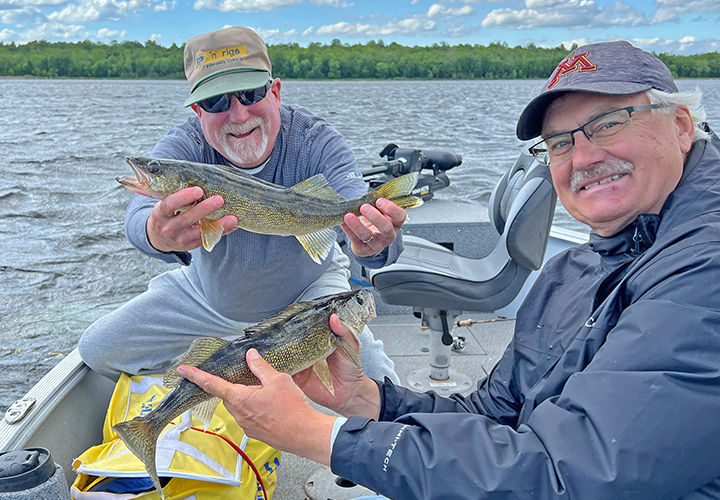 On Thursday, we experienced early signs of the summertime, mixed bag, weedline trolling pattern. Because surface water temperatures were cool, ranging between 66 to 67 degrees, the pattern favored cooler water species like pike and perch, especially early in the day. In fact, northern pike we are biting so ferociously that other fish had little chance to find their way to the spinners. Later, the pecking order shifted, pike action slowed, and walleyes, along with a couple of crappies showed up in the mix.
On Thursday, we experienced early signs of the summertime, mixed bag, weedline trolling pattern. Because surface water temperatures were cool, ranging between 66 to 67 degrees, the pattern favored cooler water species like pike and perch, especially early in the day. In fact, northern pike we are biting so ferociously that other fish had little chance to find their way to the spinners. Later, the pecking order shifted, pike action slowed, and walleyes, along with a couple of crappies showed up in the mix.
Wandering away from the weeds was a waste of time on Thursday. Whenever I moved deeper to check steeper breaklines, or open water structures, the action dried up. There were times when I tried to beat the system of trolling for the mixed bag. When I moved out over mid lake structures, and jigging with minnows and night crawlers, we found only an occasional fish, mostly pike, with a few stray perch and 1 walleye in the mix.
All I had to do was move back to the weedline, resume trolling with spinners and the action started all over again. The spinners were routine, about 30 inches long, #3 hammered gold, or copper Indiana blades, 2/0 single Aberdeen hooks and tipped mostly with fatheads. I experimented using night crawlers, and caught some fish, but found them to be no significant advantage.
Key depths ranged between 6 and 8 feet deep, and occasionally deeper, 10 to 12 feet whenever I detected patches of submerged vegetation growing in deeper water. Those deeper patches were different than the shallow ones, instead of cabbage weeds, there were wispy, narrow leaf plants growing. Nobody ever snagged any, so I didn’t get a chance to I.D. them. I suspect that they were some variety of eelgrass, fries’ pondweed or a similar pondweed variety. These deeper patches are the spots where we caught the crappies. I was tempted to stop, and re-tool so we could check for more, but with walleyes being our main target, did not experiment with alternative crappie presentations.
I supposed we caught upwards of 100 pike, so the action was fast. And by the end of our fishing trip, we had caught just enough walleyes to call it a good day. This, combined with the fact that shiner minnow supplies are drying up, will likely encourage me to do more trolling, and less jigging in the coming days and weeks.
Today, dark skies and breezy conditions give me the idea to try for a combo smallmouth and walleye trip on one of the area’s clear water lakes. I’m planning to do some wiggle worming, and maybe some wacky worming in the shallows too. I’ll let you know how that goes in a day or two. ![]() — Jeff Sundin, The Early Bird Fishing Guide Office Cell Call or Text 218-245-9858 or Email on Facebook on X
— Jeff Sundin, The Early Bird Fishing Guide Office Cell Call or Text 218-245-9858 or Email on Facebook on X
 June 12, 2025 "Did Barometric Pressure Kill Our Fishing Trip?"
June 12, 2025 "Did Barometric Pressure Kill Our Fishing Trip?"
 Every so often, I get hit with a “zinger” a day when most fish just seem to stop biting. Sometimes, I know the specific reason, but sometimes I just plain don’t. Take yesterday for example, no matter where I went, and no matter what we fished with, the best we could do was to pick up occasional singles that were too stupid not to bite.
Every so often, I get hit with a “zinger” a day when most fish just seem to stop biting. Sometimes, I know the specific reason, but sometimes I just plain don’t. Take yesterday for example, no matter where I went, and no matter what we fished with, the best we could do was to pick up occasional singles that were too stupid not to bite.
The experience would have been less dumbfounding if I’d taken my crew on an adventure to a lake that we haven’t fished lately. The problem was that this happened on Lake Winnie, in the same areas we fished in the day before and enjoyed good multi-species action. That’s right, on Tuesday, we trolled spinners in the weeds and caught a nice mixed bag of crappies, pike and walleye, we fished jigs on the bars and caught walleyes too. And on the flats, there were anglers hauling in good numbers of fish by simply drifting with the wind and getting random bites.
So, what changed? Well, the variables make knowing for sure tricky. Sunshine and calm seas didn’t help, especially out on the main lake where water clarity remains extremely high. But in the weeds, and in the darker water of the flowages, and back bays, I should have been able to scrounge up at least some fish, but I didn’t. The passing of the full moon was likely influential, but that’s difficulty to prove, and highly speculative. So, I’m thinking that most likely, barometric pressure was probably the culprit.
I recall a conversation with Scott Hall, formerly the host of my Thursday morning radio program on KAXE. Scott turned me on to a study that linked changes in barometric pressure to discomfort caused by expanding swim bladders in fish. I found that study, a Bemidji State University paper titled “The Effect of Barometric Pressure on Feeding Activity of Yellow Perch”.
Long story short, changes in barometric pressure cause the swim bladder of a fish to expand, or contract. Discomfort from expansion would likely cause fish to be less active, while contraction would encourage an increase in feeding activity. When you think about it, it’s not much different from the feeling we get after eating a huge holiday meal; offer me food an hour after a feast and likely to say no way. But offer me a burger 12 hours later, and I’d be all in.
In my search for the aforementioned paper, I found more studies and anecdotal information too. I’ll read through some of them, and let you know which ones appear to pertain to fishing situations that we might encounter here in Minnesota.
In the meantime, I’ll try to pull out of yesterday’s slump and get the boys some fish to take home today. Hopefully, the recovery will make up for the dues we paid yesterday. ![]() — Jeff Sundin, The Early Bird Fishing Guide Office Cell Call or Text 218-245-9858 or Email on Facebook on X
— Jeff Sundin, The Early Bird Fishing Guide Office Cell Call or Text 218-245-9858 or Email on Facebook on X
 Brainerd MN Area Fishing Report June 12, 2025
Brainerd MN Area Fishing Report June 12, 2025
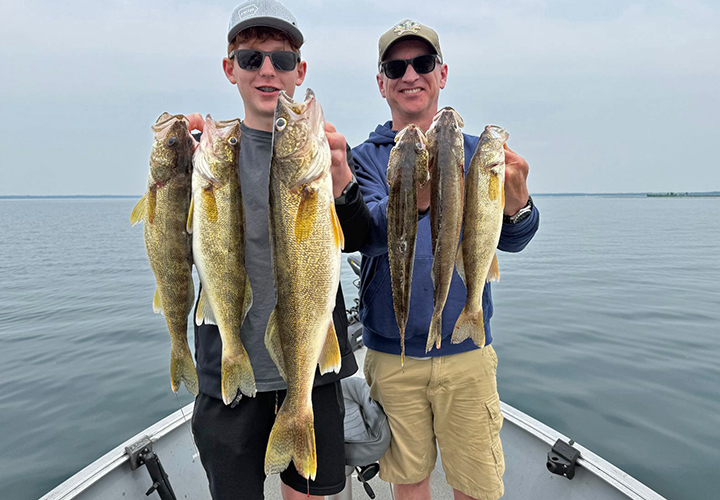 "The walleye bite in the brainerd area has been a little tricky this week. With the recent weather, fish have reacted by going into neutral-negative mood swings. Bait is abundant in the water now too, and that adds to the competition with our lures and baits.
"The walleye bite in the brainerd area has been a little tricky this week. With the recent weather, fish have reacted by going into neutral-negative mood swings. Bait is abundant in the water now too, and that adds to the competition with our lures and baits.
Slowing way down and fishing with finesse presentations, or working fast to bring lures through as many fish as possible have been keys to success. In my case I choose to cycle through as many pods of walleyes as I can and using agressive presentations for my trips.
Depths have ranged from 12 to 22 feet of water, and are holding large numbers of fish outside weedlines. Leeches and crawlers are working best along with the occasional plastic presentation. Slip bobbers or jigs tipped with live bait are a main stay in my boat for the rest of the season.
Depending lake to lake some fish will let you get within 15 feet while others won’t come within 60 feet, so keeping an eye on electronics and reading fish is crucial. Most fish currently want to feed up instead of chasing down to bottom so keeping baits 2 to 6 feet above them has worked best.
As for Muskies they are holding in the weeds but I would except a push to open water in the next coming weeks." — Joe Billiar, Crooked Hat Guide Service • 507-469-2714
 Ely Area, Arrowhead Outdoors Fishing Report June 11, 2025
Ely Area, Arrowhead Outdoors Fishing Report June 11, 2025
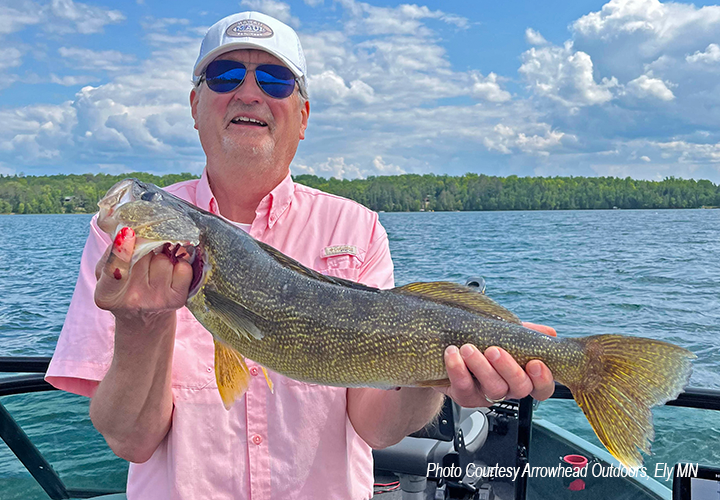 "Walleye - Walleyes continue to scatter throughout the lake with reports coming in from 3 to 6 feet of water, tight to rocky shorelines with a slip bobber and a leech, during the evening hours. Paddle tails are also catching good numbers of walleyes here too. Other anglers are catching good numbers of walleyes in 10 to 15 feet of water, off point or just off shallow flats with spinner rigs tipped with a crawler, leech or minnow. Other anglers are starting to find walleyes moving out to sunken islands that top out in that 10 to 15 feet of water. Firetiger, gold and pink continue to be the hot colors this last week.
"Walleye - Walleyes continue to scatter throughout the lake with reports coming in from 3 to 6 feet of water, tight to rocky shorelines with a slip bobber and a leech, during the evening hours. Paddle tails are also catching good numbers of walleyes here too. Other anglers are catching good numbers of walleyes in 10 to 15 feet of water, off point or just off shallow flats with spinner rigs tipped with a crawler, leech or minnow. Other anglers are starting to find walleyes moving out to sunken islands that top out in that 10 to 15 feet of water. Firetiger, gold and pink continue to be the hot colors this last week.
Smallmouth Bass - Smallies are either starting to spawn or just wrapping up their spawn on area lakes. Depending on where they are at with spawning on your lake, Ned rigs, wacky worms, in-line spinners and topwater baits have been catching good numbers of bass with a few big girls mixed in. Once these bass wrap up spawning this bite is going to get really hot! Regardless of the lake, anglers should be focusing their time in 10 feet of water, over rock/boulders, downed trees and current areas to catch smallies. Bone, Loon and green pumpkin.
Panfish - Crappie reports are starting to indicate that crappies have wrapped up their spawn on many of the Ely area lakes. Anglers are still finding some males left in the pencil reeds, but every day they are catching less and less. Anglers are now mainly finding them in or just outside on emerging weed beds and are catching them with jig and twisters or crappie minnows under a bobber. Sunfish have been replacing the crappies in the shallows. Small angle worms, wax worms and even small twisters have been catching good numbers of big gills in area lakes.
Stream Trout - Rainbow Trout bite has been lights out this last week. Anglers have been catching nice rainbows right off the dock with red and gold spoons, small twisters and crawlers fished under a bobber. For anglers fishing out in a boat, trolling small spoons, brightly colored minnow baits and even leadcoring small trolling spoons have been catching good numbers of nice trout.
Lake Trout - Cool weather has the lakers in a biting mode this last week. Reports indicate that lakers have rise up in the water column to about 15 to 25 feet of water, over deep water. Anglers are catching them trolling heavy spoons, leadcoring light trolling spoons and trolling deep diving crankbaits. Covering ground, looking for biters has really been the name of the game. Wonderbread, red/white and silver/blue have been good colors to troll with.
Northern Pike - Pike anglers have been hard to find this last week despite reports of some real giants still being caught right off the dock yet. Barbie pole with a small minnow fished under a bobber seemed to be the best way to catch pike up to 45 inches. If you're too cool to fish with a Barbie pole, heavy suckers, fished under a bobber, remains a good backup. Spoons, large minnow baits and large in-line spinners have been very effective too. Shallow bays, and river mouths remain good locations, but pike are starting to disperse out into the lake. Main lake points and emerging weedbeds are starting to hold big pike." — Arrowhead Outdoors, 218-365-5358
 Wired2Fish June 11, 2025 "[VIDEO] How to Spool a Spinning Reel with Braid"
Wired2Fish June 11, 2025 "[VIDEO] How to Spool a Spinning Reel with Braid"
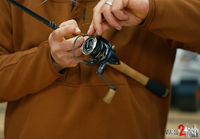 "Spooling a spinning reel the right way isn’t just about loading line—it’s about preventing slip, reducing twist, and maximizing performance. In this step-by-step video, Wired2fish’s own Kyle Peterson breaks down exactly how to spool braid with a mono backing and why each step matters.
"Spooling a spinning reel the right way isn’t just about loading line—it’s about preventing slip, reducing twist, and maximizing performance. In this step-by-step video, Wired2fish’s own Kyle Peterson breaks down exactly how to spool braid with a mono backing and why each step matters.
Why a Mono Backing is Essential: Braid lacks stretch and grip, which means it can slip around the arbor under tension. To prevent this, Peterson starts by adding mono as backing. The mono grips the spool better, creating a secure base layer that locks the braid in place.
Choosing Mono Based on Arbor Size: The size of a reel’s arbor determines which mono line works best. A smaller arbor calls for lighter, thinner mono, while a larger arbor can support heavier mono. Peterson uses 8-pound mono for his setup, but stresses the importance of matching the backing to the reel size to avoid bulking.
Quick, Effective Knots for Reliability: Rather than tying complex knots, Peterson uses a ..." View Video to Learn More >> How to Spool a Spinning Reel with Braid
 Lake of the Woods, LOW Tourism June 11, 2025
Lake of the Woods, LOW Tourism June 11, 2025
 "It's another great week of fishing on the south side of Lake of the Woods! A couple of days, anglers changed up where they fished based on weather, but overall, people caught fish.
"It's another great week of fishing on the south side of Lake of the Woods! A couple of days, anglers changed up where they fished based on weather, but overall, people caught fish.
Walleyes are active, but they’re also beginning to transition in how they’re feeding and where they’re hanging out. The jig bite remains strong in many areas, but some anglers are now switching things up to spinners with great results. Some anglers are still anchoring or spot-locking and jigging with frozen emerald shiners, which continue to be a top bait. A 3/8 to 1/2 oz jig is ideal. Some are experimenting with leeches on their jigs and finding good success, especially as water temps rise. Don’t forget to try those classic LOW colors—gold, glow white, chartreuse, pink, or combinations like gold/glow white/pink.
Some anglers are starting to pull spinners with good walleye success. Most are using crawlers on their spinner rigs, but switching over to a minnow once in a while can also produce better results some days. This time of year, it pays to be versatile. Good spinner colors are similar to jig colors, hammered gold combined with pink, glow white, orange and glow red are good options.
Some anglers have reported excellent walleye action in 14 to 18 feet of water, tied to a dragonfly hatch in some areas. Walleyes are feeding on these larvae that emerge from the bottom. Throughout the summer, various bug hatches around the lake can concentrate fish in specific areas—keep your eyes open for these fish catching opportunities.
Trolling crankbaits is also gaining momentum and is catching walleyes as water temps continue to climb. Crankbaits help anglers cover water quickly and find scattered fish. It’s a great way to target walleyes and can produce bonus species like pike, smallmouth bass and perch. As for depth, fish are being caught everywhere from shallow sand in 8 feet to deep mud and rocks in 31 feet. That 14 to 18 and 25 to 29-foot range have been particularly productive.
 The Rainy River is still holding some decent walleyes. As water temps rise and the current remains steady, a 1/2 to 3/4 oz jig tipped with a frozen emerald shiner remains effective, especially when vertically jigged in deeper holes and along the channel edges.
The Rainy River is still holding some decent walleyes. As water temps rise and the current remains steady, a 1/2 to 3/4 oz jig tipped with a frozen emerald shiner remains effective, especially when vertically jigged in deeper holes and along the channel edges.
Looking to change things up? Spinners with crawlers or trolling crankbaits are great ways to explore and find active fish. Want even more variety? Casting crankbaits, spinnerbaits, or swim jigs along shorelines, docks, and back bays can always be a productive option producing a mixed bag that includes walleyes, pike, and smallmouth bass.
Reminder: The sturgeon season is currently closed, but will reopen July 1st. From July 1 through September 30, anglers with a sturgeon tag can harvest one sturgeon per year—either 45–50 inches or over 75 inches.
Up at the Northwest Angle, fishing continues to be excellent. Walleyes are being caught in 12 to 24 feet of water, particularly around shoreline structure, underwater points, and shallow reefs. The jig and minnow bite is still going strong, especially on rock and sand transitions.
Trolling crankbaits along shallow structure has also been productive. This approach is helping anglers cover water and locate schools of feeding fish. In addition to walleyes, many are catching jumbo perch, pike, and smallmouth bass.
Speaking of bass—now is a great time to target smallmouth. June is a month that can be really productive simply working shorelines. Focus on points, scattered rubble and small areas of structure.
Looking ahead: The muskie opener in both Minnesota and Ontario Zone 5 is coming up June 21, 2025. With Lake of the Woods’ healthy muskie population and 14,552 islands to explore, anglers are getting ready for another great muskie season!
Plan Your Trip. Lake of the Woods continues to produce consistent catches of nice walleyes. Some anglers bring their own boats. Others prefer to board a charter boat or in with a guide. Whether you’re jigging, pulling spinners, trolling cranks, or casting for a mixed bag, the lake is healthy and good catches are being reported around the lake." — Lake of the Woods Tourism, (800) 382-FISH
 June 10, 2025 "Suffering? For Our Sport"
June 10, 2025 "Suffering? For Our Sport"
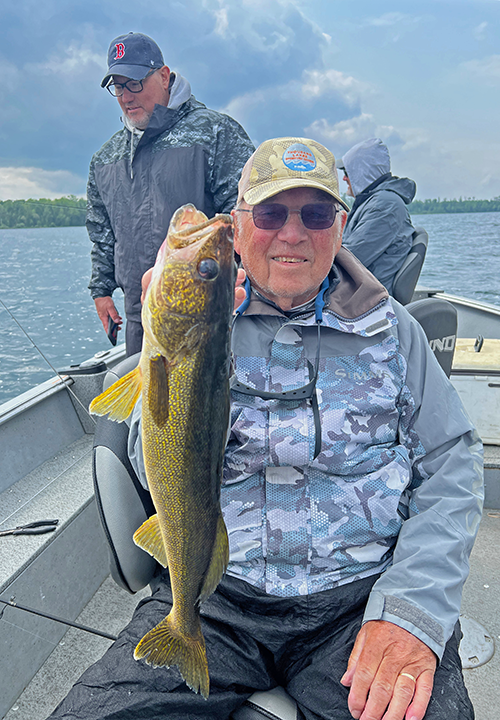 I mentioned yesterday that I’d be fishing with the Gandy family, and that they may possibly be the longest running customers I still have. Well, longest running or not, they’ve been coming for a long time, since 1991 we think. During those 34 years, they’ve seen plenty of rain, wind, and cold weather. So, yesterday’s cold front didn’t throw them off … too much, they made the best of it and in return for their “suffering”, caught a lot of fish.
I mentioned yesterday that I’d be fishing with the Gandy family, and that they may possibly be the longest running customers I still have. Well, longest running or not, they’ve been coming for a long time, since 1991 we think. During those 34 years, they’ve seen plenty of rain, wind, and cold weather. So, yesterday’s cold front didn’t throw them off … too much, they made the best of it and in return for their “suffering”, caught a lot of fish.
The weather, cold, drizzly, and windy, drove surface water temperatures down. Whitecaps on the surface, driven by a stiff northwest wind we good for fish activity, but the cold 63-degree surface temperatures had driven fish away from where I found them last week.
The 4 degrees drop moved smallmouth bass off of the rock tops in shallow, 3-to-5-foot water. Now, they are located at the base of rock pikes, in water depths of around 10 to 12 feet. Walleyes, formerly located at the base line of weed patches in 10 to 12 feet, were forced in 2 directions. Some of them were found in 16 to 20 feet, off the edges of weedy breaklines. There were others, like the one you see pictured that hunkered down in the heaviest cabbage beds the lake has to offer. Both structures had their advantages, and both had their disadvantages too.
Fishing the weeds was good because fish were more active. Smallmouth bass, northern pike, perch, crappies and walleyes were all present and all were willing to strike. Using 1/8-ounce jigs tipped with minnows was simple and effective. Many of the fish were small though, and between catching and releasing lots of “throw backs” and snagging in the heavy weeds, we were burning through our minnow supplies at an alarming rate.
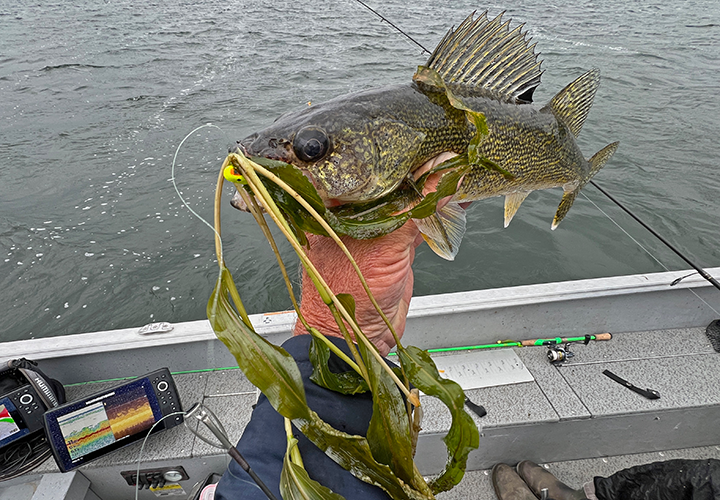 Moving to deeper structure was good because it was easy to see fish on the graph, and it seemed like there were more walleyes, out target species, than other species. The problems were that these fish were less aggressive, and there were more rocks. So, fishing more slowly to accommodate the finicky strikers meant getting snagged on the rocks more often. The boys often missed fish or hooked and lost more fish on these structures too, and that can be frustrating.
Moving to deeper structure was good because it was easy to see fish on the graph, and it seemed like there were more walleyes, out target species, than other species. The problems were that these fish were less aggressive, and there were more rocks. So, fishing more slowly to accommodate the finicky strikers meant getting snagged on the rocks more often. The boys often missed fish or hooked and lost more fish on these structures too, and that can be frustrating.
Alternative presentations, like wiggle worming and using plastic tails on the jigs didn’t help yesterday. The only fish that struck my paddle tails were northerns and small perch. Walleyes struck the jig and night crawler combos but were tentative and very difficult to hook. For me, finessing the fish to strike was fairly easy, but getting reliable hook sets was not. With cold fingers, and a swift current, this presentation wasn’t gonna work for the crew.
We stuck with the jigs and minnows, used up the supply of larger minnows, and then did the best we could using the smaller fatheads, and glorified crappie minnows in the reserve tank. By about 5:00 PM, we had a dozen keeper walleyes, a half dozen crappies and 2 pike. We’d released a lot of fish too, numerous walleyes from the protected slot, lots of small mouths and more pike and perch than we wanted.
So, despite cold fingers, shivery knees and drippy noses, it’s hard to say that we “suffered” for our sport. We just put up with Mother Nature and her quirky taste in good fishing weather. ![]() — Jeff Sundin, The Early Bird Fishing Guide Office Cell Call or Text 218-245-9858 or Email on Facebook on X
— Jeff Sundin, The Early Bird Fishing Guide Office Cell Call or Text 218-245-9858 or Email on Facebook on X
 June 10, 2025 "Correction: Lead Fishing Tackle Ban, Not Yet In Effect"
June 10, 2025 "Correction: Lead Fishing Tackle Ban, Not Yet In Effect"
Correction: On Sunday, regarding the ban on sales of lead fishing lures in Minnesota this summer. My (formerly trusted) source for that information was wrong, and for now, the legislation appears to be stalled in the committee within the Minnesota legislature.
The bill, HF 1387, “A bill for an act relating to game and fish; prohibiting sale, manufacture, and use of lead tackle; proposing coding for new law in Minnesota Statutes, chapters 97C; 325E.”
If passed, will prohibit the use, manufacture, and sale of certain lead fishing tackle in Minnesota, specifically targeting small sinkers and jigs that weigh one ounce or less or measure 2-1/2 inches or less in length.
I’ll be following the progress of the legislation and report it here. If you want to track it yourself, follow this link to the Minnesota Legislature Office of the Revisor of Statutes
For additional information on the basis for the legislation, and more current updates about its progress, check out these articles.
- Minnesota Department of Natural Resources "Statement on use of lead ammunition and tackle"
- MPR NEWS "Governor’s fishing opener spotlights lethal impact of lead tackle to Minnesota’s loons"
- Minnesota Citizen's Portal "Minnesota legislators propose ban on lead fishing tackle effective July 2027"
- Minnesota Star Tribune "Bill to ban small lead fishing tackle's sale and use in Minnesota pushed again"
Watch for more updates as they become available and be sure to let us know whenever “new news” about this, or any new legislation catches your attention. ![]() — Jeff Sundin, The Early Bird Fishing Guide Office Cell Call or Text 218-245-9858 or Email on Facebook on X
— Jeff Sundin, The Early Bird Fishing Guide Office Cell Call or Text 218-245-9858 or Email on Facebook on X
 June 9, 2025 "Updating the Update-Able"
June 9, 2025 "Updating the Update-Able"
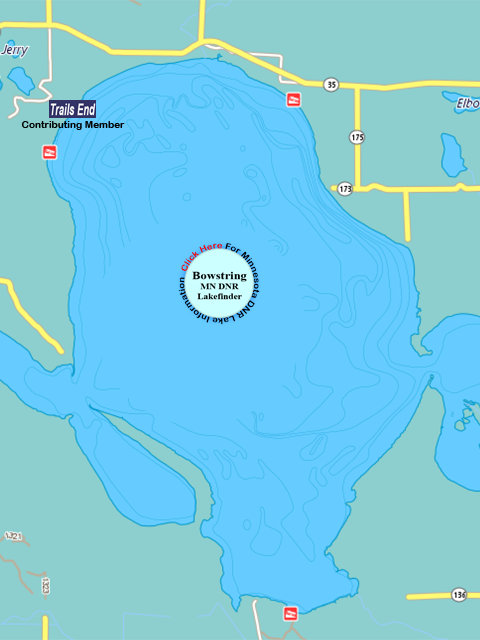 Yesterday, as I reported, was my cleanup, rest up, fix up and pay up day. So, with my boat parked safely in the barn, I went through emails and work notes that are ready for updates and reminders. Here are a few notes that may be helpful to you, or some of your fellow anglers.
Yesterday, as I reported, was my cleanup, rest up, fix up and pay up day. So, with my boat parked safely in the barn, I went through emails and work notes that are ready for updates and reminders. Here are a few notes that may be helpful to you, or some of your fellow anglers.
A note from Dale Engrav; “Hi Jeff, do you know how the boat landings on Bowstring are for depth to launching a boat this year? Some years have been difficult. Also how has the fishing been lately, are there walleyes hitting leeches yet? Thanks Dale Engrav”
Dale, in most of my home territory, the north central Minnesota lakes region is in a drought. Bowstring, along with many of the other shallow, river fed lakes in the region have low water levels. Back on May 29, 2925 (Read Full Report) I wrote a full report regarding Bowstring Lake.
On that trip, we attempted to launch at the landing sit in the northwest corner, the one adjacent to Northern Acres Resort. The water there was too shallow for my boat, so we drove over to Trails End Resort to try their ramp. Bill Charlton at Trails End helped me there, and we did get my boat into the water, but only because of him, wearing chest waders, standing in the lake and muscling my boat both off, and back onto the trailer at days end.
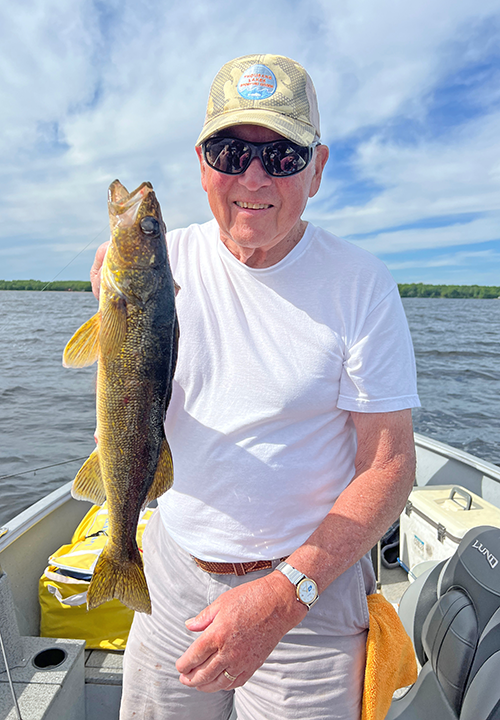 Anecdotal accounts from friends indicate that the landing in the northeast corner is even lower, and most people simply can’t get in, or out at the landing. The south landing is fairing better, and most boats, except for large, heavy ones on bunk trailers, can come and go from there. I have not used that landing this summer, but for me, that landing has never been too shallow to use, even during the worst drought seasons we’ve experienced.
Anecdotal accounts from friends indicate that the landing in the northeast corner is even lower, and most people simply can’t get in, or out at the landing. The south landing is fairing better, and most boats, except for large, heavy ones on bunk trailers, can come and go from there. I have not used that landing this summer, but for me, that landing has never been too shallow to use, even during the worst drought seasons we’ve experienced.
That trip on May 29 was my only day on Bowstring, so in terms of fishing the lake, I’m not up to speed. I do hear that some of the better guides in the area are fishing there, and that’s usually a signal that there’s something happening.
As a rule, in early June, walleyes would respond well to live bait rigging with night crawlers and leeches. But historically, there’s some overlap during this period, and jig-minnow combinations often work at the same time. Last year, on (June 11, 2024), I wrote a full accounting of two trips to Bowstring in which “Wiggle Worming” was the feature presentation.
I’m speculating now, but if I was headed there today, I’d pack some leeches, some minnows and some night crawlers. I’d check mid-lake structure first, and try both rigging live bait, and slip bobbers. If that wasn’t working, I would check shoreline breaks in water depths of 10 to 20 feet, and I’d try jigging with both minnows and night crawlers. If that failed me, my next stop would be shallow breaklines and weed edges, and I’d start there by trolling spinners tipped with minnows. And if I encountered walleyes, would then switch to rigging leeches, or wiggle worming.
 June 9, 2025 Update: “Lost and Found” Notice, May 29, 2025 Gosh Dam Place, Deer River MN
June 9, 2025 Update: “Lost and Found” Notice, May 29, 2025 Gosh Dam Place, Deer River MN
Remember my post about about an item I recovered at the fish cleaning station at the Gosh Dam Place? Well, it still has has not been answered. If you, or somebody you know mentions losing something when they cleaned fish there on or about May 26-27-28, let me know. I do still have the item, safely tucked way and would love to return it to its rightful owner.
 Minnesota Ban on Sale of Lead Fishing Lures and Sinkers July 1, 2025 Deadline Approaching
Minnesota Ban on Sale of Lead Fishing Lures and Sinkers July 1, 2025 Deadline Approaching
Are you aware of Minnesota’s ban on lead fishing lures. Yes, it will soon be unlawful to sell lead fishing lures in the state. As of July 1, 2025, we will no longer be allowed to purchase jigs, sinkers, or any lead fishing product that do not meet certain size restrictions. Anglers will be allowed to continue fishing with lead fishing lures for about another year, with the state imposing a deadline of July 1, 2026, marking the end of their legal use.
 Back in about 2011-2012, when my shop was destroyed and I got out of the fishing lure business, I packed up thousands of jigs that were in various stages of production. Among them, there are several thousand of the original “Bug Eyed Shorty Jigs” that I once produced.
Back in about 2011-2012, when my shop was destroyed and I got out of the fishing lure business, I packed up thousands of jigs that were in various stages of production. Among them, there are several thousand of the original “Bug Eyed Shorty Jigs” that I once produced.
There are many more of them than I will ever be able to use during the next year. So, I’ve decided to share them with you. Most of these new, old stock, fishing jigs are un-painted, so you’ll have to paint them yourself. Some are primer painted with white vinyl paint; any would be fairly easy for any handy angler to finish.
Besides the Bug Eyes, there are also some premium round heads with Red, Lazer Sharp Hooks, long shank jigs and the aspirin shaped, short shank model that were highly popular at the time.
If you’d like to purchase some of these jigs, for your own use, before the June 30, 2025, deadline, let me know. Call or text 218-245-9858 or email for more information.
 Lake Winnibigoshish Input Group Accepting Applications
Lake Winnibigoshish Input Group Accepting Applications
On Friday, I received a call from Dan Schermerhorn, MN DNR Large Lake Specialist. He let me know that the Grand Rapids Area Fisheries off is officially taking applications for the newly formed Lake Winnibigoshish Input Group. For those Lake Winnie enthusiasts among us wish that your voice could be heard, now is the time to step up and apply.
MN DNR Fisheries: “The DNR is seeking people with a range of perspectives and experiences, including local fishing guides, local anglers, anglers from across Minnesota, local businesses and local resorts, and water-based businesses. The group will work closely with the DNR to provide input on fisheries management activities, including any activities that are authorized, licensed, permitted, or otherwise regulated or managed by the state.
Minnesotans can apply online through Tuesday, June 24, 2025, to serve on the fisheries input group for Lake Winnibigoshish. The DNR supports the group by supplying information relevant to their discussions, including standard fish population assessments, creel (angler) surveys, status of invasive species, or other available information requested by the groups. For more information about the group, and to apply, visit ... >> Lake Winnibigoshish Home Page the Minnesota DNR Website.
![]() Today, I’m back at work, fishing with a family that have been with me for almost 40 years now. That’s right, the Gandy family, I’m thinking, are now the longest running customers remaining. Some trips have gone better than others, but for this crew, you can bet that I’ll give it everything I’ve got! Details to follow on Tuesday morning.
Today, I’m back at work, fishing with a family that have been with me for almost 40 years now. That’s right, the Gandy family, I’m thinking, are now the longest running customers remaining. Some trips have gone better than others, but for this crew, you can bet that I’ll give it everything I’ve got! Details to follow on Tuesday morning. ![]() — Jeff Sundin, The Early Bird Fishing Guide Office Cell Call or Text 218-245-9858 or Email on Facebook on X
— Jeff Sundin, The Early Bird Fishing Guide Office Cell Call or Text 218-245-9858 or Email on Facebook on X
 June 8, 2025 "A Semi-Action Packed Family Fishing Trip"
June 8, 2025 "A Semi-Action Packed Family Fishing Trip"
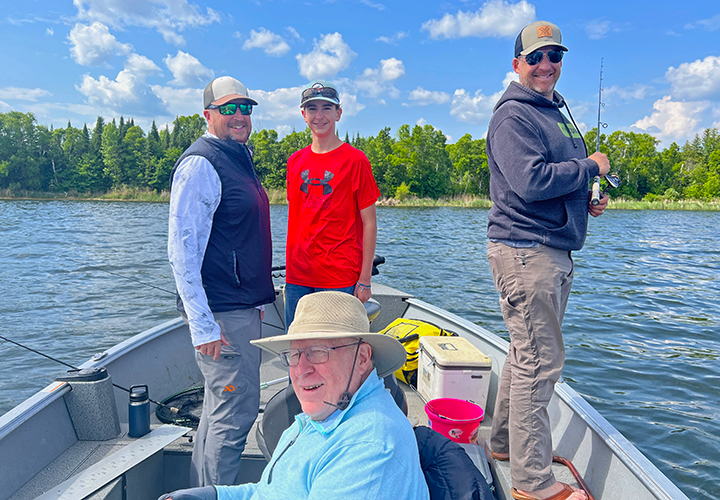 I guess that the best way to recap the last 2 days of fishing with the Jacobs family is to say it was "Semi-Action Packed". For Dean, Erik, Adam and Cade, the presentations, the catch rates and the harvest were all fairly routine for an early June trip. We fished one big lake, and one small lake, both days targeting primarily walleyes, but both days also catching other species that came along in the mix. We harvested plenty, we released plenty more and we moved between spot a lot.
I guess that the best way to recap the last 2 days of fishing with the Jacobs family is to say it was "Semi-Action Packed". For Dean, Erik, Adam and Cade, the presentations, the catch rates and the harvest were all fairly routine for an early June trip. We fished one big lake, and one small lake, both days targeting primarily walleyes, but both days also catching other species that came along in the mix. We harvested plenty, we released plenty more and we moved between spot a lot.
Day one, Winnibigosh was chosen because the conditions were favorable for a full boat. It was calmer than I’d prefer, and sunnier too, but despite less-than-ideal weather conditions, the walleyes were semi-cooperative. We were able to catch one or two fish at almost every stop but never caught more than a few before the small schools would disperse.
On the big lake, bars and humps are becoming more productive than shoreline structures. So, early in our day we jumped from one hump to another, dropping ¼ ounce jigs, tipped with shiners. Almost always, we’d get strikes immediately, sometimes walleyes, sometimes northern pike. Almost always, we’d get 1 or 2 fish into the boat but lose 1 or 2 fish in the process. The fish, both species, were tentative when striking, and to get good hook sets, we had to nurse the strikes along and wait for fish to fully engulf the lures and bait.
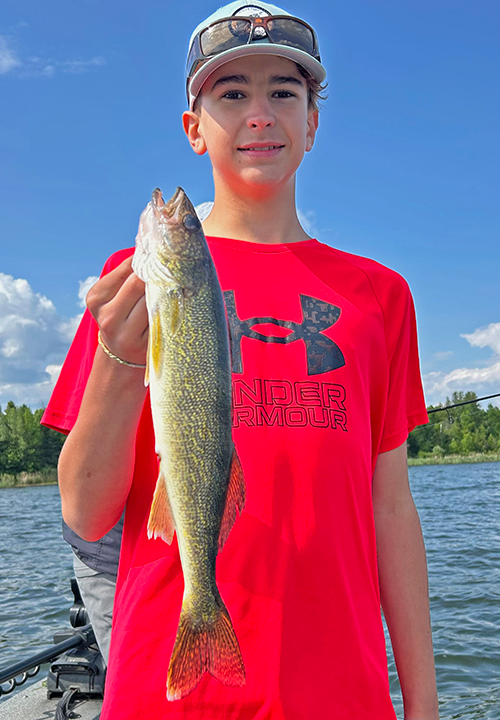 Key depths ranged from 18 to 24 feet of water, and I was able to find fish in that range wherever we stopped. Whenever I’m fishing over mid-lake structure, I have the depth setting on my graph locked in at 26 feet. So, if there were any fish deeper than that, I don’t know about them, and I don’t want to know about them. On Winnie, especially this year, odds are 50-50, at best, that any walleye will be in the protected slot. So, avoiding deep fish, to reduce the risk of barotrauma damage, is the best practice, in my opinion.
Key depths ranged from 18 to 24 feet of water, and I was able to find fish in that range wherever we stopped. Whenever I’m fishing over mid-lake structure, I have the depth setting on my graph locked in at 26 feet. So, if there were any fish deeper than that, I don’t know about them, and I don’t want to know about them. On Winnie, especially this year, odds are 50-50, at best, that any walleye will be in the protected slot. So, avoiding deep fish, to reduce the risk of barotrauma damage, is the best practice, in my opinion.
By about 11:00 AM, I decided to leave the humps, and try fishing on Winnie’s west side flats. Again, we hooked fish at almost every stop, and again, there was a good number of pike mixed in with the walleyes. Key depths on the flats ranged from 12 to 15 feet, and the sweet spot was about 14 feet deep. The water is not as clear as it was last week, it is still super-clear. Fishing vertically, below the boat was a waste of time, we could see the bottom with our eyes, and knew that there were no fish there. But casting our jigs out and away from the boat and retrieving them with an aggressive hop-drop-hop-drop motion produced strikes. Plastic paddle tails, on long shank ¼ ounce jig heads also produced some fish on the flats.
Next, we experimented with a couple of the larger bars, Moses, and Sugar to be specific. Again, there were a few fish at each stop and at 2 out of 3, they bit. At the 3rd stop, the fish snubbed us completely, that’s when I decided to search the weeds.
After a long boat ride to a back bay, we located a nice cabbage stand in to 8 feet of water. Jigging with 1/8-ounce live bait jigs and minnows, we discovered a mix of fish including perch, pike, walleye, in that order. As a bonus, Adam and Cade each caught 1 crappie, but I did not pinpoint any large school of them. I suppose we fished the weeds for a couple of hours, we boated more slot-fish than keepers, but we did also add a few more walleyes to the larder.
By days end, our harvest was modest, 9 walleyes and 2 crappies. But the benefit of fishing on Winnie right now is that the “keepers” are beautiful, as the accompany photo reveals, 16-1/2 to 17-1/2 inches each. The Jacobs didn’t want to harvest any pike, but on Friday, it would have been easy to drop a half dozen chunky ones in the livewell. Despite their short length, they were plump, and would have been perfect for blackening, or pan frying.
On day 2, Saturday, the forecasted breezy conditions and cloudy skies would have been perfect for a re-match at Winnie. But the large size of my crew, along with some concerns about lower back issues, made smaller water a better option. So, we fished a 3000-acre, multi-species lake instead.
 In some ways, the fishing report is almost identical to what we did on Winnie the day before. We found a few fish at almost every stop but never landed on a motherlode. A mix of northern pike, walleye, and smallmouth bass kept us busy. The best areas were mid-lake bars, and shoreline points that extend into the lake’s mid-section. Weed edges in 12 to 14 feet of water were best for walleyes, shallow water rocks in 5 to 9 feet of water were best for smallmouth bass. On this day, northern pike seemed to be everywhere, we caught more of them than usual on this lake.
In some ways, the fishing report is almost identical to what we did on Winnie the day before. We found a few fish at almost every stop but never landed on a motherlode. A mix of northern pike, walleye, and smallmouth bass kept us busy. The best areas were mid-lake bars, and shoreline points that extend into the lake’s mid-section. Weed edges in 12 to 14 feet of water were best for walleyes, shallow water rocks in 5 to 9 feet of water were best for smallmouth bass. On this day, northern pike seemed to be everywhere, we caught more of them than usual on this lake.
Like the crappie bonus we had on Friday, there were a couple of bonus crappies here too. We caught them late in the day, so I didn’t have time to search for more. But where we caught them made us think that there may have been more of them located nearby. The fuzzy stuff you see on the screen of my graph are plants called Fries' Pondweed. It’s like eelgrass, or flat stemmed pondweed, both excellent cover types for early summer crappies.
The fish were holding in those weeds, but not along the outer edges. The jigs and minnows we were using for walleyes were not ideally suited to the wispy habitat; they were easily fouled by the soft and clingy plants. If we’d re-tooled and fished with a more “weed friendly” presentation, we may have picked up some more. A 1/16 ounce jig tipped with a smaller minnow and suspended below a clip on bobber worked well for me on Thursday. I think it would have been a good choice here as well.
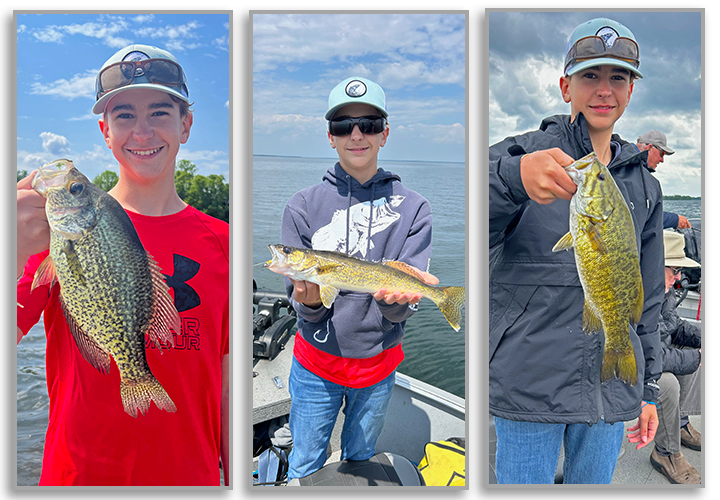 The presentation we used was primary 1/8-ounce live bait jigs tipped with shiners, and they worked well. But experimenting with wiggle worming, and slip bobbers and leeches showed promise as well. Because it was windy, jigging was a good option, but if it had been calm, I think the bobbers might have been a better choice.
The presentation we used was primary 1/8-ounce live bait jigs tipped with shiners, and they worked well. But experimenting with wiggle worming, and slip bobbers and leeches showed promise as well. Because it was windy, jigging was a good option, but if it had been calm, I think the bobbers might have been a better choice.
So I guess that's why I decided that the best way to recap the past 2 days was “semi-action packed.” There were a lot of stops and starts, combined with spurts of good fishing. By the end of the trip, all 4 of my crew’s limits were filled and there were lots of fish released along the way. Cade Jacobs, now 13 years old, is a man of few words, so I’m not sure how he’ll tell the story, but it I think was a good trip for him. If I was 13, caught my first walleye, and a 14 inch crappie, and some nice size smallmouth bass, I’d probably feel good about the experience, how about you?
Today is cleanup, rest up, fix up and pay up day. So. I doubt my boat will get wet. That makes this a good time to drop me a line with questions, comments or reports from your recent fishing trip. Let me know what you think, and I’ll share your thoughts with readers tomorrow morning. ![]() — Jeff Sundin, The Early Bird Fishing Guide Office Cell Call or Text 218-245-9858 or Email on Facebook on X
— Jeff Sundin, The Early Bird Fishing Guide Office Cell Call or Text 218-245-9858 or Email on Facebook on X
 Cutfoot Sioux, Lake Winnie Memorial Day Fishing Report June 7, 2025
Cutfoot Sioux, Lake Winnie Memorial Day Fishing Report June 7, 2025
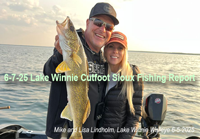 "A week of moderate weather and gentle breezes has brought both Lake Winnie and Cutfoot Sioux to life. Walleyes, crappies, sunfish and perch are transitioning into early summer patterns. Surface water temperatures vary from one region of the lake to another and now range between 65 and 68 degrees. Water clarity, still high, has moderated somewhat, measuring at about 18 feet deep, vs the 22-foot readings reported about a week ago.
"A week of moderate weather and gentle breezes has brought both Lake Winnie and Cutfoot Sioux to life. Walleyes, crappies, sunfish and perch are transitioning into early summer patterns. Surface water temperatures vary from one region of the lake to another and now range between 65 and 68 degrees. Water clarity, still high, has moderated somewhat, measuring at about 18 feet deep, vs the 22-foot readings reported about a week ago.
On clear water lakes throughout north central Minnesota, “boat-shyness” has been commonly cited as a hinderance to walleye angler success. The term is used to describe flighty behavior of fish that become intolerant of boats approaching too closely. “Cubby” (Jeff) Skelly fished on the big lake a few days back and reported that walleyes showed some tolerance for allowing him to hover above and fish vertically.
Yesterday, the Jacobs group, fishing with another area fishing guide encountered sunshine and calm water. Walleyes were flighty, they reported, but despite the bright conditions, the group caught fish in a wide variety of locations around the big lake. There were several scattered pods of fish located on ..." Read >> Bowen Lodge Lake Winnie Fishing Report June 7, 2025
 June 6, 2025 "The Perfect Fishing Day? Succeeding at the Succeed-Able"
June 6, 2025 "The Perfect Fishing Day? Succeeding at the Succeed-Able"
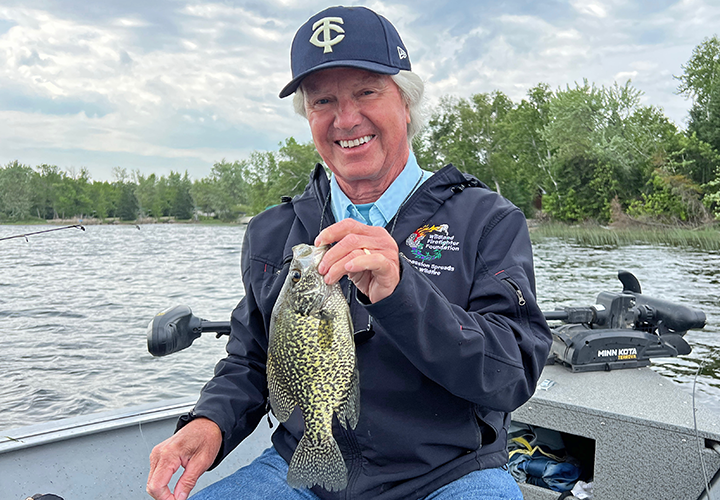 Some people I fish with think that a good fishing day is measured by whether there’s a “limit” of dead fish in the cooler at the end of their trip. But fishing with folks who instead measure success by the enjoyment of their experience is a lot more gratifying.
Some people I fish with think that a good fishing day is measured by whether there’s a “limit” of dead fish in the cooler at the end of their trip. But fishing with folks who instead measure success by the enjoyment of their experience is a lot more gratifying.
Don’t get me wrong, I don’t have anything against harvesting fish to eat, in fact I love it. And on days like yesterday, when I fished with Marty and Janet Christensen, we do harvest fish; but we factor in FUN, over numbers, as the true measurement of success. The benefit of that is that we can fish a variety of spots, experiment with multiple techniques and switch target species when conditions turn favorable. Yesterday’s fishing trip was a perfect example of philosophy.
When we arrived at the lake, the sun was shining, the surface was clam, and the water was warm. Surface temperatures ranged between 67 and 69 degrees, and the lake looked alive. There were minnows and small sunfish swimming across the shallow flat near the boat ramp. Insects were hovering low above the surface of the water and an Osprey, clutching panfish, flew over our boat. “Let’s see how the morning goes”, I said. “We may wind up back here looking for some of those sunfish if things are going well. But while it’s calm, let’s go check out the cabbage weeds to see if crappies are there.”
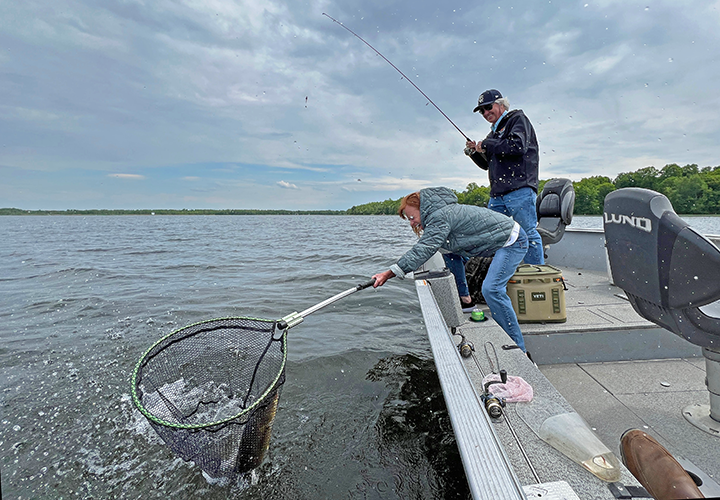 In the calm water, finding the cabbage patches was easy, we could see the tops sticking up above the surface. Crappies were there alright, but under the bright sunshine, hunkered down in the weeds. Unlike my trip on Wednesday, casting plastics or spinner jigs, was only semi-effective, triggering just a few strikes. Switching over to bobber fishing worked better, at first we used 1/16-ounce jigs tipped with small fatheads. That presentation worked fine, but whenever I tried tipping a jig with a 1-inch Berkely Nymph, the action intensified. The crappies really loved that small lure, and for a time, the action was fast.
In the calm water, finding the cabbage patches was easy, we could see the tops sticking up above the surface. Crappies were there alright, but under the bright sunshine, hunkered down in the weeds. Unlike my trip on Wednesday, casting plastics or spinner jigs, was only semi-effective, triggering just a few strikes. Switching over to bobber fishing worked better, at first we used 1/16-ounce jigs tipped with small fatheads. That presentation worked fine, but whenever I tried tipping a jig with a 1-inch Berkely Nymph, the action intensified. The crappies really loved that small lure, and for a time, the action was fast.
When a line of dark clouds, and accompanying claps of thunder approached the lake, things changed. Whitecaps on the surface made the presentation difficult and rather than fight the conditions, I opted to switch gears. A point that extended out from the shoreline provided a break from the wind. Thinking we might find some of those sunfish, we tucked into the calmer water and began creeping along the weedline with the trolling motor.
Still using the bobbers, and the 1–16-ounce jigs tipped with the Nymphs, we floated them over the weed tops in 6 to 7 feet of water. At first, we found more crappies, but eventually somebody caught a bluegill. That’s when I switched back to using meat, instead of plastic on the jigs. A cut piece of nightcrawler, threaded onto the jigs did trigger more sunfish strikes. We harvested 4 of them that were just over 8 inches long, it was fun, but despite fast action, most of the fish were too small to keep. Instead, of searching for a new sunfish spot, we decided to switch gears again.
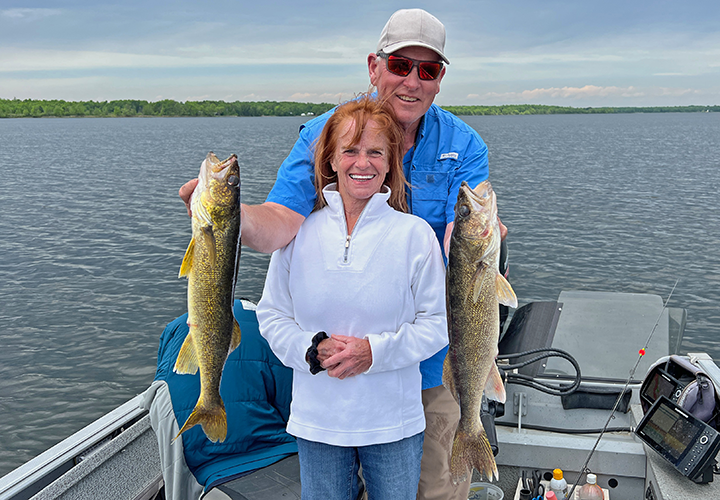 After a short break at the landing, I re-rigged two rods with Lindy Rigs and set up one rod for wiggle worming. We moved back to a shoreline point and started slowly trolling the breakline. Marty was using a leech, Janet was rigging with an air injected night crawler and I, the “wiggle worm guy” used a 1/16-ounce live bait jig tipped with a whole night crawler. It took a little while, and there were a couple of missed strikes, but once Janet connected with the first walleye, the action improved.
After a short break at the landing, I re-rigged two rods with Lindy Rigs and set up one rod for wiggle worming. We moved back to a shoreline point and started slowly trolling the breakline. Marty was using a leech, Janet was rigging with an air injected night crawler and I, the “wiggle worm guy” used a 1/16-ounce live bait jig tipped with a whole night crawler. It took a little while, and there were a couple of missed strikes, but once Janet connected with the first walleye, the action improved.
I don’t think we caught a walleye using the leeches, and experimenting with a minnow on the Lindy Rig failed to produce too. So, after seeing a few walleyes caught on yard bait, Marty switched over to worms too. That worked, and from then on, we all caught some fish. The action was steady, but not fast, we fished for about 3 hours and caught maybe a dozen walleyes total. Of those, 4 were “keepers” and the rest were in the protected, 20-to-24-inch slot.
I don’t think the method of delivering the night crawlers was crucial. I held my own using the wiggle worms, and so did Marty and Janet. If we used the crawlers, our walleyes were happy.
I guess you could call this my first purposeful multi-species fishing trip of the season. Each species that we tried to catch were cooperative, and catching each required a slightly different presentation. We could have gone all in and tried to finish off the limit of any one of the species, but by now it’s almost 4:00 PM, and we’ve caught a little bit of everything. Instead of digging in our heels, we decided to wrap it up for the day.
As far as limits were concerned, we were short on everything, except fun! Opinions may vary, but from our perspective, calling this “The Perfect Fishing Day” would not be a stretch, not at all. ![]() — Jeff Sundin, The Early Bird Fishing Guide Office Cell Call or Text 218-245-9858 or Email on Facebook on X Photo Book
— Jeff Sundin, The Early Bird Fishing Guide Office Cell Call or Text 218-245-9858 or Email on Facebook on X Photo Book
 June 5, 2025 "Now Is The Time For My Favorite Crappie Pattern"
June 5, 2025 "Now Is The Time For My Favorite Crappie Pattern"
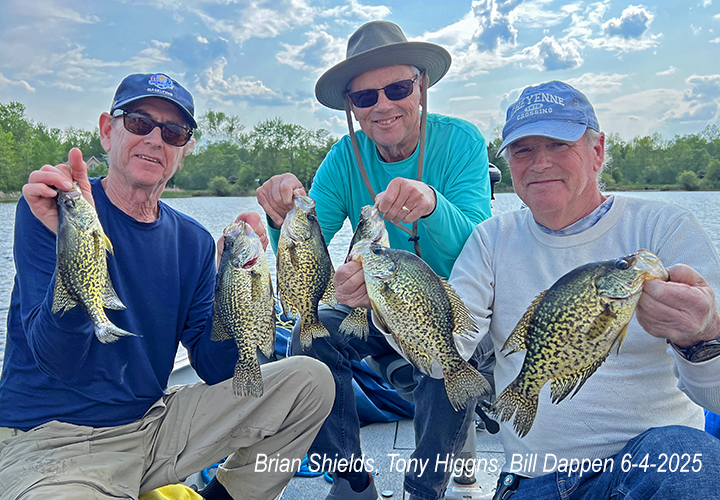 The time has come; my favorite crappie fishing pattern of the entire year has begun producing good results. What it is, is the post-spawn period when crappies move away from their shallow water spawning habitats, and into leafy and woody structures.
The time has come; my favorite crappie fishing pattern of the entire year has begun producing good results. What it is, is the post-spawn period when crappies move away from their shallow water spawning habitats, and into leafy and woody structures.
Cabbage patches, like the one you see pictured here, are an ideal example of leafy structure. For me, a lake that has lots of cabbage is the perfect hunting ground for this pattern. But crappies are incredibly adaptable, and there are other vegetation types like coontail, or eelgrass that can also be good, especially in lakes that have little or no cabbage varieties.
Woody structure, like sunken tree branches, boat docks and swimming rafts can be good if they provide the right cover and are located in proximity to crappie spawning habitat. A good tree branch is one that’s fallen into the water over a steep drop off and provides overhead cover in water depths of 4 to 12 feet.
A good boat dock would provide similar deeper water, overhead cover. A tree branch or boat dock lying on a shallow water flat may hold a few bass, or other panfish, but are not what crappies look for. Again, crappies are adaptable, so almost anything laying in the water could be worth checking out, provided the surrounding water is deep enough, 4 to 12 feet, to provide cover for crappies.
For me and my crew, cabbage, my favorite, was available, and there were certain patches holding fish on Wednesday. The best ones were located in water depths of 5 to 8 feet, and adjacent to a steep breakline dropping into about 16 feet on the deep side. On the shallow side, the cabbage weeds were adjacent to a bulrush flat in water depths of 2 to 4 feet. Some of the crappies were holding tight to the cabbage plants, but there were some fish on the flats surrounding the heaviest weeds too.
The question of “best” presentations is an interesting one. Each of us found one lure that suited our personal preferences, and they were all a little bit different.
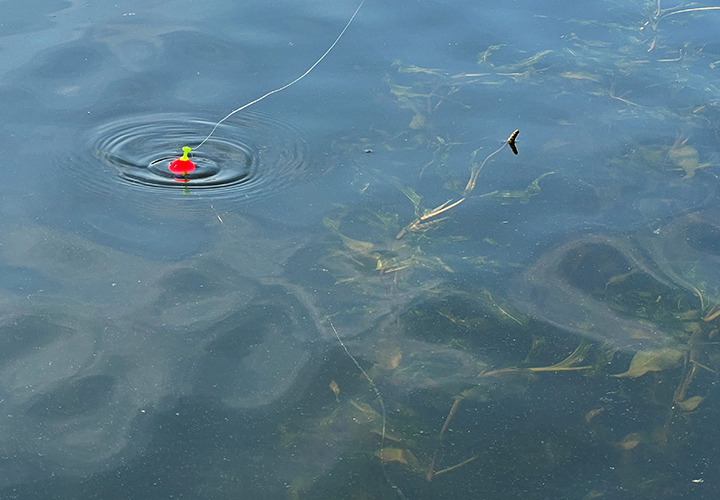 Bill was using some beetle spin type lures that had 2-to-3-inch twirl tails, instead of the classic “beetle” type of plastic tail. For him, the 1/8-ounce safety pin spinners worked like a charm. Cast the lure, let it drop a couple feet, then retrieve it using a steady swimming motion. The sweet spot, for Bill, was about 2 to 3 feet below the surface, and over the tops of the weeds.
Bill was using some beetle spin type lures that had 2-to-3-inch twirl tails, instead of the classic “beetle” type of plastic tail. For him, the 1/8-ounce safety pin spinners worked like a charm. Cast the lure, let it drop a couple feet, then retrieve it using a steady swimming motion. The sweet spot, for Bill, was about 2 to 3 feet below the surface, and over the tops of the weeds.
Tony had his best luck using a 1/16 round jig head tipped with a 2-inch, Strike King Crappie Killer tail. Using that lure, casting toward the cabbage and allowing it to drop into gaps and pockets worked best. Cast the lure, and on a tight line, let it fall couple feet, then swim it through the weeds, back toward the boat. Often, fish followed the lure out of the weeds and struck as the jig reached the side of the boat.
Brian did his best work using a 1/16-ounce live bait jig tipped with a small fathead. Suspended about 3 feet below a 1-inch clip on float, he cast the lure into the gaps between cabbage plants. Allowing the presentation to sit in each pocket for a few seconds was enough time to either catch a fish or rule out the individual spot.
I’m thinking that almost any lure would have worked, it was simple a matter of figuring out angler preferences. You’re probably thinking about one of your favorite lures and wondering why that one wouldn’t work. My guess is that it probably will provided that it works in the type of cover I’ve described.
One thing that did not work for us was trolling with spinners. Later on this summer, spinners will become highly effective, but yesterday, the presentation was too fast for crappies. We did catch both pike, and a couple of walleyes trolling, but even they showed a preference for slower and more deliberate presentations.
I’m short on time this morning and can’t give a full account of what the walleyes were doing yesterday. But we did catch some, and so did other anglers on the lake, and I’ll drop that information, along with anything I learn today, on you tomorrow morning. ![]() — Jeff Sundin, The Early Bird Fishing Guide Office Cell Call or Text 218-245-9858 or Email on Facebook on X
— Jeff Sundin, The Early Bird Fishing Guide Office Cell Call or Text 218-245-9858 or Email on Facebook on X
 Ely Area, Arrowhead Outdoors Fishing Report June 4, 2025
Ely Area, Arrowhead Outdoors Fishing Report June 4, 2025
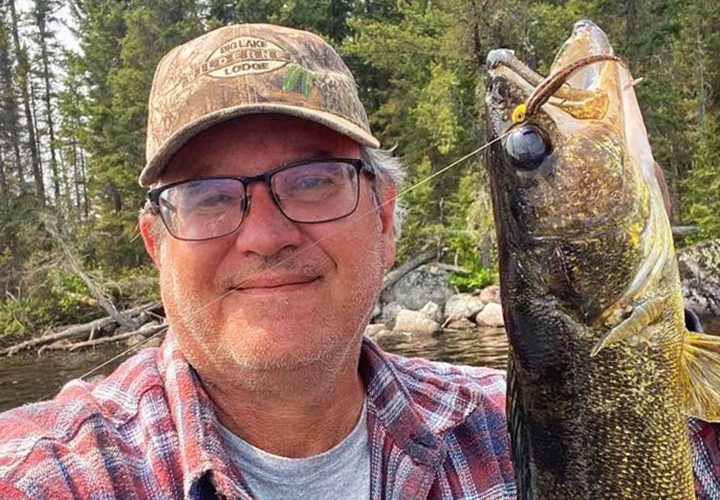 "Walleye • Thanks to another heat wave walleyes are starting to behave a little more normal, for this time of the year. While minnows continue to rain supreme, the slip bobber and leech bite has finally started.
"Walleye • Thanks to another heat wave walleyes are starting to behave a little more normal, for this time of the year. While minnows continue to rain supreme, the slip bobber and leech bite has finally started.
Anglers have been pitching jigs and minnows, paddle tail and minnow baits. Basically anything that looks like a minnow, fished in 3 to 7 feet of the water. Reason for this is that minnows are looking to spawn now. Current areas are a good start, but large boulder flats and rocky shorelines have been the best areas to fish. In the evenings a slip bobber and a juicy leech has been the most effective. Right off the dock and back to shore or right off your campsite after dinner, has been where anglers are catching walleyes under a slip bobber. Gold, pink and firetiger have been the most popular colors this last week.
Smallmouth Bass • With water temps finally getting up into the 60 degree range and smallmouth bass have begun to move up on their beds looking to spawn. You anglers who fish love to fish with Ned rigs, now is your time. Other anglers have been having incredible fishing with pink mepps, wacky worms, topwater, jerk baits. Key areas to fish have been large rocky flats, pretty much anywhere on the lake, as long as it's in 4 to 8 feet of water. Pink, green pumpkin, and orange craw.
Northern Pike • While anglers fishing for pike cooled off this last week, anglers flashing pictures of big pike in the shop didn't. Big pike remain in the shallow bays in 4 to 7 feet of water. Fishing with a large sucker remains the best way to go if you want a fish of a lifetime, but more and more we are hearing that spoons, spinners and buzzbaits are catching good numbers of pike with some big pike sprinkled in.
Panfish • Crappies have rapped up spawning on some lakes or just started on others. Either way anglers should be looking for crappies in the shallow pencil reeds where they find the sand bottoms they need to spawn on. Small hair jigs, tube jigs or crappie minnow, all fished under a bobber, have been very effective. Sunnies too can be found in these same areas by anglers. Small red worms, wax worms or small leeches, fished under a bobber, have been deadly for big sunnies.
Stream Trout • Rainbows have been very active this last week. Anglers fishing from shore have been reporting great fishing mainly during the evening hours, right off the dock. Small red and gold kastmasters have been super effective, but the tried and true nightcrawler, fished 5 to 10 feet under a bobber has been effective too. Anglers fishing in a boat or canoe have been doing good trolling small minnow baits while trolling right along the shoreline. Brighter the bait, the better.
Lake Trout • Lake Trout reports continue to trickle in as more anglers start looking for lakers. Anglers have been finding lakers anywhere from 7 to 80 feet of water. Anglers finding them shallow have been looking for smallies or walleyes when they hooked into a lake trout. Anglers targeting lakers have been trolling with down riggers in 40 to 80 feet of water with large trolling spoons. Anglers fishing from a canoe have been trolling or jigging over deep water (same depth) with smaller spoons, tube jigs or bucktails. Wonderbread, blue jeans and bloody nose have been popular colors for lakers." — Arrowhead Outdoors, 218-365-5358
 Wired2Fish June 4, 2025 "Jig Fishing for Bass: Basic and Advanced Techniques"
Wired2Fish June 4, 2025 "Jig Fishing for Bass: Basic and Advanced Techniques"
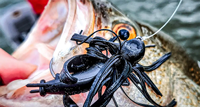 "Of all the lures in the world in the realm of bass fishing, there’s none more popular than a skirted jig. If you were to ask any professional bass angler on any of today’s circuits, they’d tell you a jig is their number-one fish-catching lure in their boat. It has a record of putting both numbers and big fish in the boat year after year. It’s a lure that has accounted for more fish caught than any other lure on the market today, and for good reason — they flat-out work.
"Of all the lures in the world in the realm of bass fishing, there’s none more popular than a skirted jig. If you were to ask any professional bass angler on any of today’s circuits, they’d tell you a jig is their number-one fish-catching lure in their boat. It has a record of putting both numbers and big fish in the boat year after year. It’s a lure that has accounted for more fish caught than any other lure on the market today, and for good reason — they flat-out work.
Whether the times are tough and you’re looking for a bite, or it’s on fire and you love feeling that “tick” as they slurp it down, you can always count on a jig to get the job done.
But what exactly is a jig? What does it imitate? How do you work it correctly? How many different types of jigs are there? A lot of anglers ..." Read Article to Learn More >> Jig Fishing for Bass: Basic and Advanced Techniques
 Lake of the Woods, LOW Tourism June 4, 2025
Lake of the Woods, LOW Tourism June 4, 2025
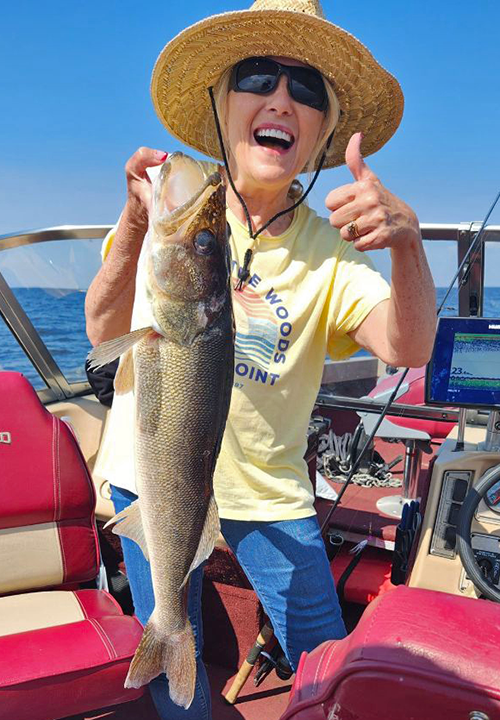 "The bite continues to be red-hot on Lake of the Woods, with walleyes and saugers providing plenty of action across many areas! Whether you're targeting shallow sand, deep mud, or rocky structure, fish are active and hungry.
"The bite continues to be red-hot on Lake of the Woods, with walleyes and saugers providing plenty of action across many areas! Whether you're targeting shallow sand, deep mud, or rocky structure, fish are active and hungry.
Along the South Shore, the jig bite remains the top producer for walleyes and sauger! Anglers are finding both in a wide range of depths, with the 23 to 28-foot range being especially productive. Walleyes are relating to various forage opportunities, showing up on sand, mud, and rock alike.
The most effective technique continues to be anchoring up or spot-locking and jigging. A 3/8 to 1/2 ounce jig tipped with a frozen emerald shiner is the go-to bait. Don't forget those bright colors in the stained waters of L.O.W. Gold-glow-white, gold-chartreuse, gold-glow-pink, or straight gold are all catching walleyes.
There are still some good size northern pike lingering on the shoreline, and pike are still being caught by unsuspecting walleye anglers. While many have moved into the main lake, some big northerns are still lingering in the shallows, offering an exciting change of pace if you're looking for a fight.
The Rainy River is still yielding some fantastic walleyes! With climbing water temperatures and steady current, a 3/4 ounce jig tipped with a frozen emerald shiner is working well. Most anglers are vertically jigging in deeper holes or just off the main channel. Four Mile Bay continues to be productive, especially when fishing the channel edges and slowing your presentation.
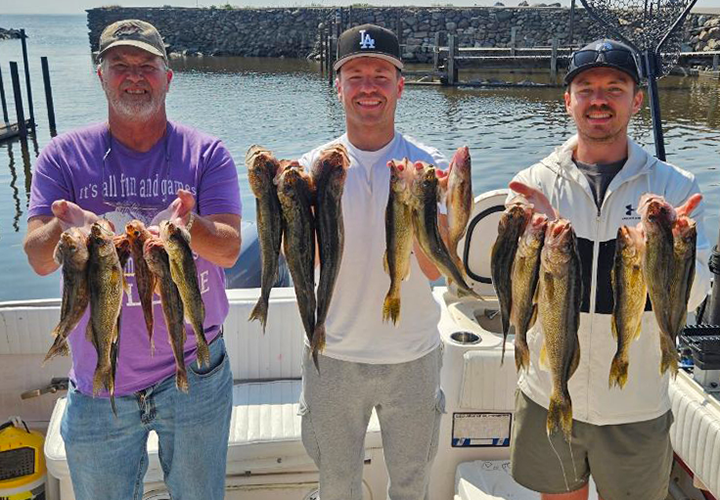 For those looking to cover more water and find active fish, consider switching to spinner rigs tipped with crawlers or trolling crankbaits. If you're up for a fun challenge, try casting crankbaits, swim jigs, or spinnerbaits along the shoreline, around docks, or into the bays for multispecies action.
For those looking to cover more water and find active fish, consider switching to spinner rigs tipped with crawlers or trolling crankbaits. If you're up for a fun challenge, try casting crankbaits, swim jigs, or spinnerbaits along the shoreline, around docks, or into the bays for multispecies action.
The sturgeon season is currently closed but will reopen on July 1, 2025. From July 1 through September 30, 2025, anglers with a sturgeon tag are allowed to harvest one sturgeon per calendar year, the legal sizes for harvest must be between either 45 to 50 inches, or over 75 inches in length.
Up at the Northwest Angle, excellent fishing continues at the Northwest Angle! Walleyes are being found in 12 to 24 feet of water, particularly off shoreline structure, points, and shallow reefs. The jig and minnow bite remains strong, with most anglers anchoring up and working rock or sand transitions.
In addition to jigging, trolling crankbaits along shallow shoreline structure in 6 to 9 feet of water is producing walleyes as well as a mixed bag. Points, underwater points and rock rubble areas are holding good numbers of fish. Trolling is a great way to cover water and locate active, feeding fish.
Muskie anglers, the muskie opener is June 21st for both Minnesota and Ontario’s Zone 5. As most muskie anglers know, the lake is healthy for muskies right now. With 14,552 islands, there are plenty of places to spread out and fish." — Lake of the Woods Tourism, (800) 382-FISH
 June 3, 2025 "A Smoky Afternoon of Fun with Dick and Paul, Day 4"
June 3, 2025 "A Smoky Afternoon of Fun with Dick and Paul, Day 4"
 After 3 days of grousing about not having a chop on the water, I finally got one and soon regretted it!
After 3 days of grousing about not having a chop on the water, I finally got one and soon regretted it!
Despite an improved situation for fishing and catching, the northwest breeze that developed on Monday blew in lots of smoke from the fires burning in Manitoba. Because of threats to Canadian citizens, the fire burning near Flin Flon is getting the most attention, but there are other fires too. The affected areas, north and west of Lake Winnipeg, are massive, and fires are likely to keep burning for a while.
The last time I recall smoke this intense, was when fires were burning near International Falls, and my family was fishing on Rainy Lake. That was maybe 20 years ago, give or take. Looking at the weather forecast, I expect the smoky conditions to persist for a few days before winds calm and then turn southerly again.
In terms of fishing, it was one of those days when there was always something happening. In the morning, conditions were still calm, and the sun shone through a hazy sky. We searched for crappies in shallow water bulrush patches. We did find a few of them, but the fish that were really in there were smallmouth bass. For a time, they were very active and I think we caught upwards of 20 before we moved out into deeper water.
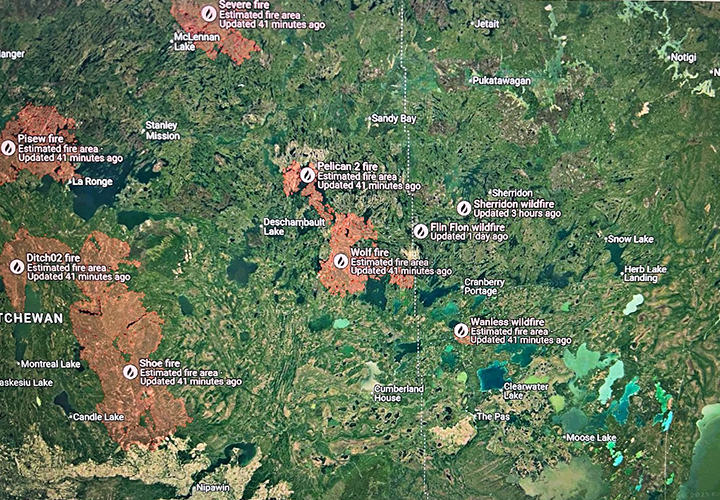 We were looking for 3 walleyes to top off the boy’s limits, and also 3 more fish for our dinner at Gosh Dam Place afterward. So, as the wind first began to blow, and a light chop developed, we got serious about walleye fishing. That was a good idea because on our first drift, at the first spot, we not only caught the half dozen we wanted, but released several others too. When that spot fizzled out, we moved and repeated the experience, catching and releasing several more walleyes.
We were looking for 3 walleyes to top off the boy’s limits, and also 3 more fish for our dinner at Gosh Dam Place afterward. So, as the wind first began to blow, and a light chop developed, we got serious about walleye fishing. That was a good idea because on our first drift, at the first spot, we not only caught the half dozen we wanted, but released several others too. When that spot fizzled out, we moved and repeated the experience, catching and releasing several more walleyes.
Presentations were simple, and familiar. For the smallmouth bass, a 1/8-ounce jig head with a 3-inch ripple shad worked well. But many of them also struck our crappie rigs, jigs and minnows set at about 3 feet below clip on bobbers. When we switched over to walleye fishing, we removed the bobbers and used the same 1/8-ounce jigs, tipped with shiner minnows. Slipping with the current, we jigged the breakline from 8 to 14 feet, and found plenty of action.
We were in no hurry to leave the lake, but as the wind intensified, so did the smoke. At the same time, a series of thunderstorms began forming in the area too. So, with nothing left to accomplish, we called it a day and headed for the GDP for dinner. As usual, the fish dinner was excellent, and the service was good.
Today is mostly play day. Unless I can stumble into a good school of perch or maybe find some more crappies, we’re looking for some larger bass, walleye or pike to catch and release. Whatever we do, I’ll fill you in tomorrow. ![]() — Jeff Sundin, The Early Bird Fishing Guide Office Cell Call or Text 218-245-9858 or Email on Facebook on X
— Jeff Sundin, The Early Bird Fishing Guide Office Cell Call or Text 218-245-9858 or Email on Facebook on X
 June 2, 2025 "Fun? (In The Sun) With Dick and Paul"
June 2, 2025 "Fun? (In The Sun) With Dick and Paul"
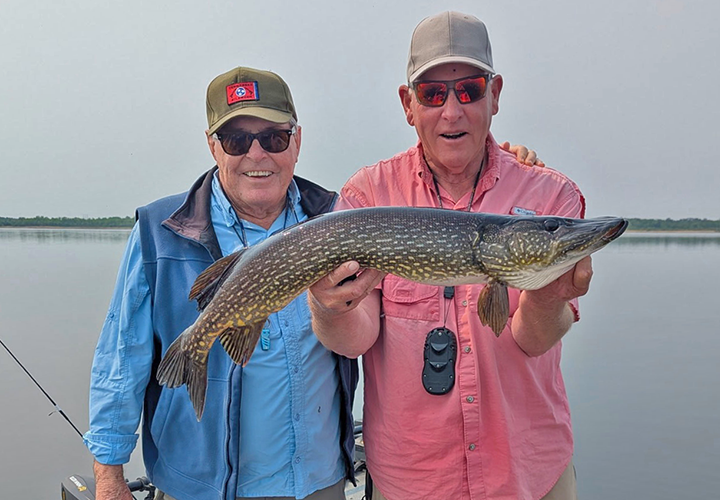 Today’s images of Dick and Paul prove one thing, there is a “highlight reel” from almost every fishing trip. What the images don’t reveal is how much effort can sometimes go into gathering those highlight images.
Today’s images of Dick and Paul prove one thing, there is a “highlight reel” from almost every fishing trip. What the images don’t reveal is how much effort can sometimes go into gathering those highlight images.
On Sunday, there was scarcely a ripple anywhere on the surface of the Deer River area lake we started fishing on. I’d hoped that those conditions would be okay because if I could get lucky, we’d find crappies either in the shallows, working spawning beds, or else in the adjacent cabbage weeds hiding in the shady cover. I knew the odds were against a re-match, but it’s happened before; this lake was once the scene of an excellent day of crappie action for me and the boys. So, hoping to at least partially re-live that experience, we headed straight for “The Crappie Hole.”
First we poked around the cabbage using small jigs tipped with minnows and suspended about 4 below clip on bobbers. There were some small perch, and small pike in the weeds, but no crappies. We moved into the shallow bulrushes next, but did not see, or catch anything there. Next, I tried the deeper outside edges of the cabbage and here, we found more perch and more pike, but still no crappies.
Okay, so the crappie hole didn’t pan out, but maybe we could pick up some walleyes or perch, I thought. We moved out deeper and followed the breakline from about 16 to 20 feet of water. Again, there were small perch, and small pike, still though, nothing to grin about. So, I moved across the lake to check out another weed patch.
 The cabbage was green and lush at that location, and on my first cast, a nice size perch smacked my jig. Then there were some smaller perch, lots of smaller pike and also the above average, 35-inch pike that Dick caught. Not long after that, Paul tossed in his 1/8-ounce jig and minnow and picked up a nice fat walleye. Maybe we’re on to something, we believed, so we turned back for another pass. The action was good, but the fish we caught on that pass were almost all smaller than we wanted. There were a lot of pike snipping off our jigs too, and re-tying lures was becoming the main focus of fishing this spot, so it was time to leave it.
The cabbage was green and lush at that location, and on my first cast, a nice size perch smacked my jig. Then there were some smaller perch, lots of smaller pike and also the above average, 35-inch pike that Dick caught. Not long after that, Paul tossed in his 1/8-ounce jig and minnow and picked up a nice fat walleye. Maybe we’re on to something, we believed, so we turned back for another pass. The action was good, but the fish we caught on that pass were almost all smaller than we wanted. There were a lot of pike snipping off our jigs too, and re-tying lures was becoming the main focus of fishing this spot, so it was time to leave it.
The whole point of fishing at this lake was to catch crappies, and since that wasn’t happening, I decided to try a different lake. So, after cleaning the boat and trailer, we drove a short distance to another small Deer River area lake. Also known as a good crappie lake, we’d have a shot at sunfish, walleyes or largemouth bass too.
At our first stop, it looked like things were gonna go our way. Casting into shallow, weedy cover we picked up 3 or 4 crappies right away. They were too small for us, but they were biting, so we tried another spot. Again, the shallow weed edges held fish, and we caught a few more small crappies, and a small bass. Still optimistic, we tried a third spot, and that’s when things went downhill.
In the calm water, hot sunshine seemed to be driving fish further and further into the weedy cover. Before long it was more work than it was worth, snagging and tugging on lily pads and bulrush isn’t that much fun. So, I started looking for fish along the deep breaklines, on some mid-lake bars and points. That strategy produced more small pike, but not anything of interest, so at about 4:30, we headed to my house for a fish fry.
We’ve still got 2 days of fishing left, but we agreed last night that we’d rather have some action, than to keep searching for any certain species for the larder. If we stumble into crappies or perch, we’ll harvest some but if we just catch and release walleye or bass, we’ll be happy with that too. So, that’s today’s plan, find something to do, that is anything that doesn’t require tying on a lot of jigs.
If you believe the weather forecast, our day might be somewhat easier today. Overcast, breezy and chances of rain developing later should work in tandem to get fish moving a little bit. So, with luck, we’ll have a “Fun Filled” day 4, of the spring session of FWDAP and you can find out about that tomorrow. ![]() — Jeff Sundin, The Early Bird Fishing Guide Office Cell Call or Text 218-245-9858 or Email on Facebook on X
— Jeff Sundin, The Early Bird Fishing Guide Office Cell Call or Text 218-245-9858 or Email on Facebook on X
 June 1, 2025 "Day 2 with Dick and Paul: Fun … For A While"
June 1, 2025 "Day 2 with Dick and Paul: Fun … For A While"
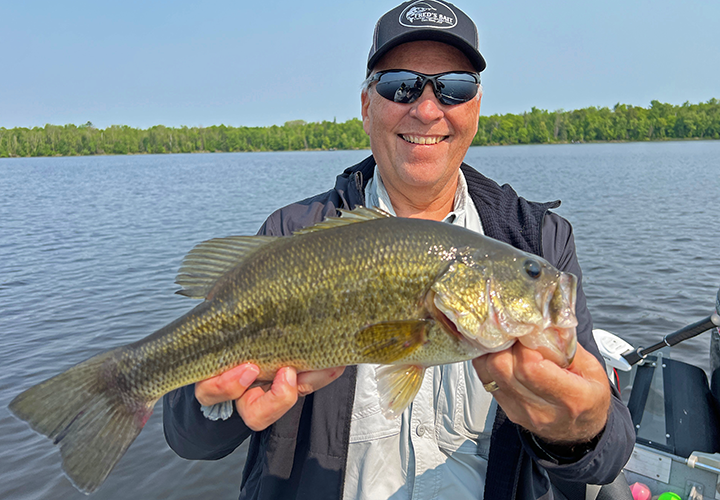 The lake a 600-acre, dark water, multi-species fishery is one that I usually fish only once each season, last year I visited twice. The lake’s dark water, less than 5 feet visibility, and weedy breaklines offer some protections on sunny, calm days, like yesterday.
The lake a 600-acre, dark water, multi-species fishery is one that I usually fish only once each season, last year I visited twice. The lake’s dark water, less than 5 feet visibility, and weedy breaklines offer some protections on sunny, calm days, like yesterday.
I’ve never left this lake with a limit of any one species, but what does usually happen, is that we leave the lake with a handful of larger than average size fish. That works great for multi-day trips like the 5-day session with Dick and Paul because we can harvest a few fish each from several lakes instead of lots of them from any single lake. What I hoped for yesterday was to get a few walleyes for dinner, a few walleyes for larder, maybe some crappies and one decent pike for the smoker.
During the morning, the plan was coming together quite nicely. We caught several walleyes at each stop, many of them small, but a few of them were “eaters” and a few more were the desired 18–20-inch size for the trip home. We caught some nice bass too, not all as nice as the one you see Paul holding here, but they were all chunky, and strong fighters. Panfish were active, and we caught several crappies too, but yesterday, the size structure was not favorable, several 8-to-10-inch crappies were the best we could muster.
Slow trolling while fishing the weed edges using jigs and minnows was the only presentation we used. But I did run into a friend on the lake, and he, with his family were trolling spinners along the weed edges and catching fish too. Truthfully, I’d have given spinners a try, but I’d left all of my ugly Sticks at home and couldn’t get set up with the necessary gear for trolling.
Somewhere around 1:00 PM the conditions caught up to me. Sunshine, calms seas and a large, Saturday crowd combined to cause a slow-down in the action. From then on, we picked up odds and ends but never had another flurry of action. At about 3:30, we discussed options, one of them being to call it quits early, and save some energy for the rest of our trip. That idea didn’t require much of a sales pitch, and within minutes we were headed toward the landing.
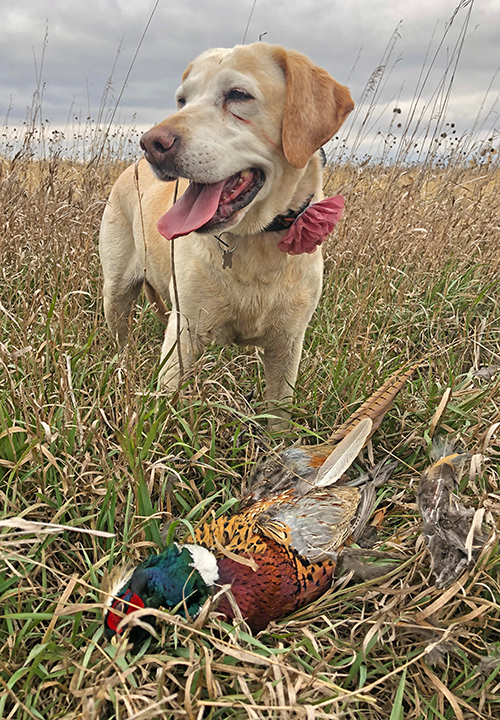 Rarely, if ever, have we decided to bag the evening fish fry either. But fueled by Florio’s restaurant’s decision to discontinue their fish dinner with customer supplied walleye, yesterday we decided to bag the fish dinner too.
Rarely, if ever, have we decided to bag the evening fish fry either. But fueled by Florio’s restaurant’s decision to discontinue their fish dinner with customer supplied walleye, yesterday we decided to bag the fish dinner too.
Apparently, the chain of events which lead to my early arrival home was divine intervention. At about 6:00 PM, our cherished yellow lab, Sandy, had what appeared to be what may have been a stroke. Without anybody in the Grand Rapids area to help, we were forced into an emergency trip to Duluth and at about 8:30 yesterday evening, Sandy drew her final breath. Surrounded by our daughter Joelle, Susan and me, she knew that those who loved her most were with her, wishing her well on her journey home. She died with a smile on her face, and I’ll always remember that moment.
We have been incredibly blessed to have had Sandy in our lives. She was the most gentle and patient dog I’ve ever known. Our grandkids could do anything with, to, and around her without as much as raising an eyebrow. They'd sit on her, rolled around with her on the floor and did whatever else babies could think about doing. She was trustworthy, personified, (well, except for around food on the counter top) and set the standard by which all other dogs will be measured, at least for our family.
For me, regrets about not having more time to take her hunting have nagged at me perennially. But I was blessed by having a dog who never judged me for my shortcomings, despite deserving a much better human. Today, I hope she's back in that field near Morris, MN where we spent her last hunting days together. "Go find 'em Sandy, go find 'em."
If you paused, even for a second and thought about saying a prayer for Sandy, and everyone who will miss her, then you’ve already done it, and for that, I thank you!
Today, I’ll be taking a shot at finding some larger size crappies. Dick and Paul have good memories from a certain Deer River area lake, and maybe we can re-live a few of those, I'll let you know. ![]() — Jeff Sundin, The Early Bird Fishing Guide Office Cell Call or Text 218-245-9858 or Email on Facebook on X
— Jeff Sundin, The Early Bird Fishing Guide Office Cell Call or Text 218-245-9858 or Email on Facebook on X
 Brainerd MN Area Fishing Report June 1, 2025
Brainerd MN Area Fishing Report June 1, 2025
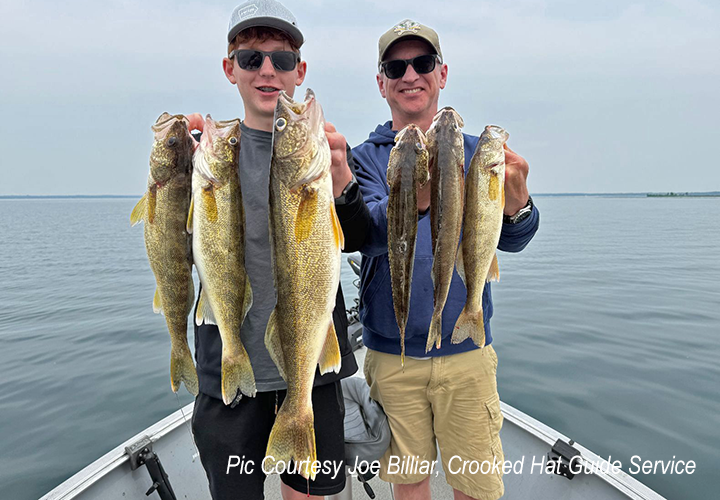 "Fishing in the brainerd lakes area has been on fire this week.Walleyes have been spread out all over the place in "small pods" consisting of 6 to 8 fish. Walleyes have been in depths ranging from 6 to 18 feet of water. Structures include both areas of mixed weeds, or where there's a hard sand bottom; both have been the top producers.
"Fishing in the brainerd lakes area has been on fire this week.Walleyes have been spread out all over the place in "small pods" consisting of 6 to 8 fish. Walleyes have been in depths ranging from 6 to 18 feet of water. Structures include both areas of mixed weeds, or where there's a hard sand bottom; both have been the top producers.
The fish (I find) on the sand have been larger in size when compared to the walleyes encountered along the weedlines, currently.
This week 90% of the walleyes have been taken on a jig and minnow. Plastics have been working as well and a bobber and crawler has produced a couple fish. With the warm up a big hatch has happened and I will predict that it will soon switch to a leech bite. Until then carry minnows, leeches, and crawlers. Water temps are around 61 degrees on most lakes. Good luck and tight lines " — Joe Billiar, Crooked Hat Guide Service
 Wired2Fish May 31, 2025 "[VIDEO] Premium Electronics Mounts: Beatdown Outdoors Walk-Through"
Wired2Fish May 31, 2025 "[VIDEO] Premium Electronics Mounts: Beatdown Outdoors Walk-Through"
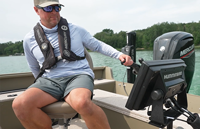 "In this video, Ryan DeChaine walks through how he upgraded his fishing boat using innovative mounting solutions from Beatdown Outdoors. The focus? Total flexibility, rock-solid rigidity, and unmatched accessibility—for any angler, in any position.
"In this video, Ryan DeChaine walks through how he upgraded his fishing boat using innovative mounting solutions from Beatdown Outdoors. The focus? Total flexibility, rock-solid rigidity, and unmatched accessibility—for any angler, in any position.
Every mount in this build prioritizes adjustability. Beatdown Outdoors offers mounts that rotate, tilt, raise, and lower effortlessly, letting you fine-tune your electronics to match how and where you fish. Whether standing at the bow or seated at the stern, these mounts make it easy to find the ideal viewing angle. You can bring displays closer, shift them out of the way, or set them at just the right height—without tools or hassle. That flexibility means fewer compromises and a better fishing experience for everyone on board.
Rigid Performance That Lasts: While the setup is flexible, the structure is ..." View Video and Learn More >> [VIDEO] Premium Electronics Mounts: Beatdown Outdoors Walk-Through
 Spring 2025 "Don't Land A Citation! Avoid These Embarrasing and Sometimes Costly Fishing-Boating Violations"
Spring 2025 "Don't Land A Citation! Avoid These Embarrasing and Sometimes Costly Fishing-Boating Violations"
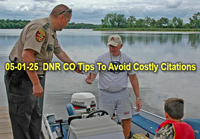 Every year, I’m amazed by the number of encounters I have with folks who commit innocent, but potentially expensive, fishing violations. Admittedly, many of the violations do not amount to anything like “crimes of the century”, but they can be both embarrasing, and costly. AND, if they’re serious enough to warrant a citation, then they’re serious enough for us to talk about here.
Every year, I’m amazed by the number of encounters I have with folks who commit innocent, but potentially expensive, fishing violations. Admittedly, many of the violations do not amount to anything like “crimes of the century”, but they can be both embarrasing, and costly. AND, if they’re serious enough to warrant a citation, then they’re serious enough for us to talk about here.
With the assistance of Minnesota DNR Enforcement, Lieutenant Colonel, Robert Gorecki, and Communications coordinator, Joe Albert, I put together a list of the more common offenses anglers make every year. To get assessments from varying geographic regions, Albert consulted with conservation offers (CO-s) from across Minnesota.
One caveat, the list I’m presenting does not cover every conceivable fishing violation, for that, you NEED to ..." Read Full Report >>
May 1, 2025 "Avoid Embarrasing and Costly Fishing and Boating Violations"
You Are Invited To Become A Duly Deputized Fishrapper Cub Reporter Too!
 If you've been waiting for a gold engraved invitation to participate in the daily reports, then stop waiting and consider this your own personal invitation.
If you've been waiting for a gold engraved invitation to participate in the daily reports, then stop waiting and consider this your own personal invitation.
Helping your fellow fishermen and women stay abreast of fishing conditions in your area is good for everybody and it's easier than you think! You don't have to write a book, you don't have to share your secret fishing spots and you don't even have to mention your lake. But even a few words about general trends, seasonal patterns and local weather conditions can really help.
Be like me, become a duly deputized "Cub Reporter", it's good for fishing! Contact Us or if you prefer to be "social", Fishing Reports Minnesota, the Facebook counterpart to this page is open to the public, so you can post your own fishing update or just share a photo of a nice catch.